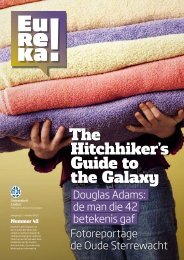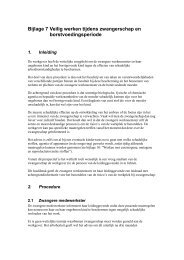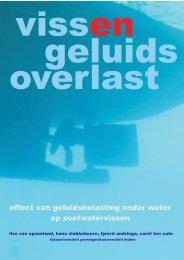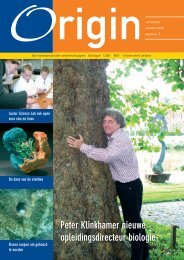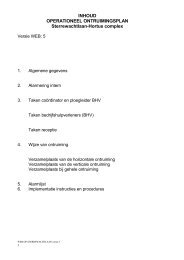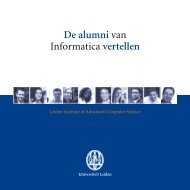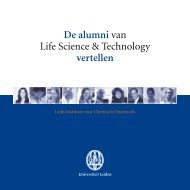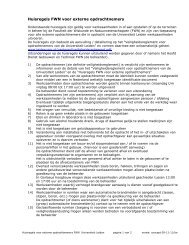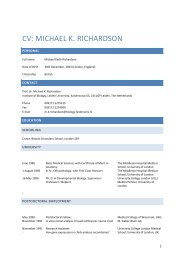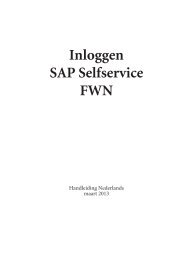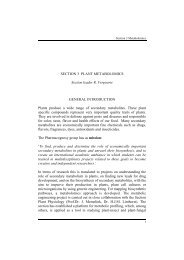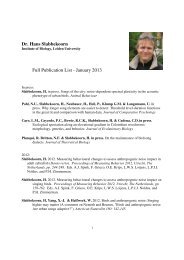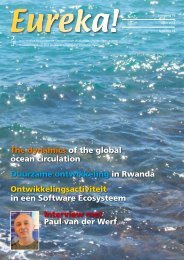infinite Beauty - Faculteit der Wiskunde en Natuurwetenschappen
infinite Beauty - Faculteit der Wiskunde en Natuurwetenschappen
infinite Beauty - Faculteit der Wiskunde en Natuurwetenschappen
You also want an ePaper? Increase the reach of your titles
YUMPU automatically turns print PDFs into web optimized ePapers that Google loves.
Bio-Farmaceutische Wet<strong>en</strong>schapp<strong>en</strong> | Biologie | LST | MST Universiteit Leid<strong>en</strong><br />
thema<br />
BeautY<br />
in sCi<strong>en</strong>Ce<br />
Culinaire Chemie met<br />
Professor mein<strong>der</strong>t danhof<br />
<strong>infinite</strong><br />
BeautY<br />
Juli 2011, jaargang 6<br />
nummer 4<br />
stud<strong>en</strong>t<strong>en</strong> <strong>en</strong> on<strong>der</strong>nem<strong>en</strong>
edactioneel<br />
Beste lezer, ik heb de eer <strong>en</strong> het g<strong>en</strong>oeg<strong>en</strong> u de<br />
eerste Origin aan te mog<strong>en</strong> kondig<strong>en</strong> on<strong>der</strong><br />
mijn hoofdredacteurschap: het themanummer<br />
Schoonheid in de Wet<strong>en</strong>schap.<br />
Zoals ook aan de vernieuwde opmaak van het<br />
vorige nummer te zi<strong>en</strong> is, is er wat betreft schoonheid<br />
op de Origin Redactie e<strong>en</strong> nieuwe weg<br />
ingeslag<strong>en</strong>, die we met dit nummer graag will<strong>en</strong><br />
doorzett<strong>en</strong>.<br />
Daarnaast blijv<strong>en</strong> we uiteraard de vaste rubriek<strong>en</strong><br />
behoud<strong>en</strong>, zoals het succesnummer “Culinaire<br />
Chemie”, dit keer met professor Danhof,<br />
iemand die ongetwijfeld veel schoonheid ziet<br />
in het werk dat hij doet. Zo ook Christian<br />
Tudorache, die “Het Mysterie van de Paling” uit<br />
de doek<strong>en</strong> doet. Het faculteitsblad van <strong>Wiskunde</strong><br />
<strong>en</strong> Natuurwet<strong>en</strong>schapp<strong>en</strong> zou uiteraard ook niet<br />
voorbij gaan aan de wet<strong>en</strong>schappelijke definities<br />
van schoonheid die door de eeuw<strong>en</strong> he<strong>en</strong> geponeerd<br />
zijn: e<strong>en</strong> interessante dialoog tuss<strong>en</strong> de<br />
“Betavraagbaak” <strong>en</strong> “Infinite <strong>Beauty</strong>”. De vraag<br />
wat schoonheid nou precies is, of betek<strong>en</strong>t, wordt<br />
dus op vele vlakk<strong>en</strong> beantwoord.<br />
Ik zie het mooie er wel van in!<br />
Rob van Wijk<br />
Hoofdredacteur<br />
Redactie Origin<br />
2<br />
origin - universiteit leid<strong>en</strong><br />
inhoud<br />
nieuws 3<br />
stud<strong>en</strong>t<strong>en</strong> <strong>en</strong> on<strong>der</strong>nem<strong>en</strong> 4<br />
Sommige stud<strong>en</strong>t<strong>en</strong> werk<strong>en</strong> in e<strong>en</strong> bar, e<strong>en</strong> winkel of verkop<strong>en</strong> abonnem<strong>en</strong>t<strong>en</strong>,<br />
an<strong>der</strong><strong>en</strong> zett<strong>en</strong> zelf e<strong>en</strong> on<strong>der</strong>neming op. Marinus Israel <strong>en</strong> Jaya<br />
Ramchandani vertell<strong>en</strong> hun verhaal.<br />
Culinary chemistry with… Professor mein<strong>der</strong>t danhof 8<br />
Join Origin in dining with the famous Mein<strong>der</strong>t Danhof and find out<br />
all about his differ<strong>en</strong>t jobs and motivations. Maybe we can ev<strong>en</strong> take a<br />
glance at the person behind this Research Achievem<strong>en</strong>t Award winning<br />
professor.<br />
de bèta-vraagbaak 14<br />
Wat is schoonheid? E<strong>en</strong> vraag met vele antwoord<strong>en</strong>. Laat u zich inwijd<strong>en</strong><br />
in e<strong>en</strong> paar theorieën, zowel wiskundig, biologisch als psychologisch.<br />
C<strong>en</strong>terfold 16<br />
E<strong>en</strong> blokk<strong>en</strong>doos voor gevor<strong>der</strong>d<strong>en</strong>.<br />
<strong>infinite</strong> <strong>Beauty</strong> 18<br />
One equation explaining all nice things in the world, an <strong>infinite</strong> number<br />
covering all the <strong>infinite</strong> beauty. What do Iron Cakes have to do with this?<br />
special: <strong>Beauty</strong> in sci<strong>en</strong>ce 21<br />
Sci<strong>en</strong>ce is cold, hard facts, nothing more. Is it? Museum Boerhaave<br />
showed beautiful images of sci<strong>en</strong>tific experim<strong>en</strong>ts, leading to thoughts<br />
about beauty in sci<strong>en</strong>ce. Was Voltaire right wh<strong>en</strong> he said: “<strong>Beauty</strong> of a<br />
work: we must feel it and be affected by it”?<br />
luminol: feit<strong>en</strong> <strong>en</strong> fictie 26<br />
Steekpartij<strong>en</strong>, doodslag <strong>en</strong> moord. Allemaal zak<strong>en</strong> waar bloed aan kleeft.<br />
Hoe goed je ook schoonmaakt, het chemische stofje luminol zal het weggepoetste<br />
bloed vind<strong>en</strong>. Of maakt CSI ons maar iets wijs?<br />
het mysterie van de paling 28<br />
Paling<strong>en</strong> word<strong>en</strong> met uitsterv<strong>en</strong> bedreigd, na 40 miljo<strong>en</strong> jaar succesvol<br />
bestaan. E<strong>en</strong> zoektocht naar de voortplantingscyclus van deze won<strong>der</strong>lijke<br />
dier<strong>en</strong>, die 6.000 km zwemm<strong>en</strong> naar dieptes van 2.000 m om te par<strong>en</strong>!<br />
ag<strong>en</strong>da <strong>en</strong> Colofon 31<br />
4 12 21 28
nieuws<br />
antibiotica gezocht! team leid<strong>en</strong> naar finale<br />
academische jaarprijs<br />
Team Leid<strong>en</strong> gaat door naar de finale van de Academische<br />
Jaarprijs. Het team wordt gecoördineerd door Prof. Gilles<br />
van Wezel (Leid<strong>en</strong> Institute of Chemistry) <strong>en</strong> Dr. D<strong>en</strong>nis<br />
Claess<strong>en</strong> (Institute Biology Leid<strong>en</strong>) in sam<strong>en</strong>werking met<br />
Dr. Willem van Wamel van Erasmus MC. Het team on<strong>der</strong>zoekt<br />
hoe ziek<strong>en</strong>huisbacteri<strong>en</strong> ontstaan <strong>en</strong> hoe de juiste antibiotia<br />
gevond<strong>en</strong> kunn<strong>en</strong> word<strong>en</strong>. Met de uitbraak van de<br />
EHEC-bacterie in het achterhoofd kan de speurtocht van<br />
Team Leid<strong>en</strong> het verschil gaan mak<strong>en</strong>! De Academische<br />
Jaarprijs is bestemd voor de beste vertaling van wet<strong>en</strong>schappelijk<br />
on<strong>der</strong>zoek naar e<strong>en</strong> breed publiek. Het team<br />
met het meest creatieve <strong>en</strong> overtuig<strong>en</strong>de communicatieplan<br />
ontvangt de hoofdprijs van 100.000 euro om het ingedi<strong>en</strong>de<br />
plan te realiser<strong>en</strong>. De drie finalist<strong>en</strong>teams werk<strong>en</strong> de kom<strong>en</strong>de<br />
maand<strong>en</strong> hun plann<strong>en</strong> uit <strong>en</strong> pres<strong>en</strong>ter<strong>en</strong> deze op<br />
26 oktober 2011 tijd<strong>en</strong>s de finaleavond aan de jury, pers <strong>en</strong><br />
het publiek.<br />
Bron: www.sci<strong>en</strong>ce.leid<strong>en</strong>univ.nl<br />
leid<strong>en</strong> institute of Chemistry sleept vier nWo eCho<br />
subsidies binn<strong>en</strong><br />
Naast de 2 TOP grants heeft het LIC ook nog 4 ECHO’s<br />
binn<strong>en</strong>gehaald voor dr. Francesco Buda, professor Gijs van<br />
<strong>der</strong> Marel met Jero<strong>en</strong> Codée, dr. Dmitri Filippov <strong>en</strong> professor<br />
Gilles van Wezel. ECHO-subsidies zijn projectsubsidies<br />
van 260.000 euro, bedoeld voor Excell<strong>en</strong>t CHemisch<br />
On<strong>der</strong>zoek. Deze subsidies bied<strong>en</strong> de mogelijkheid om<br />
nieuwsgierigheidsgedrev<strong>en</strong> on<strong>der</strong>zoek van hoge kwaliteit te<br />
kunn<strong>en</strong> uitvoer<strong>en</strong>. Zo kunn<strong>en</strong> creatieve risicovolle ideeën<br />
word<strong>en</strong> uitgewerkt, de kiem<strong>en</strong> word<strong>en</strong> gevormd voor de<br />
nieuWs<br />
on<strong>der</strong>zoeksthema’s van de toekomst <strong>en</strong>/of wet<strong>en</strong>schappelijke<br />
vernieuwing tot stand word<strong>en</strong> gebracht.<br />
Bron: www.sci<strong>en</strong>ce.leid<strong>en</strong>univ.nl<br />
drie van de vier nWo-toP subsidies voor leid<strong>en</strong><br />
NWO heeft landelijk vier TOP subsidies toegek<strong>en</strong>d voor<br />
wet<strong>en</strong>schappelijk on<strong>der</strong>zoek, drie daarvan ging<strong>en</strong> naar<br />
Leid<strong>en</strong>. In totaal zijn er landelijk 24 voorstell<strong>en</strong> ingedi<strong>en</strong>d.<br />
Naast de gehonoreerde subsidie van professor Ad IJzerman<br />
zijn ook de voorstell<strong>en</strong> van professor Marc Koper met dr.<br />
Ludo Juurlink <strong>en</strong> professor Geert- Jan Kroes gehonoreerd.<br />
NWO TOP-subsidies zijn bedoeld voor gevestigde (bio-)<br />
chemische / chemisch-technologische top-on<strong>der</strong>zoeksgroep<strong>en</strong><br />
met e<strong>en</strong> bewez<strong>en</strong> track record. De subsidies bied<strong>en</strong><br />
deze groep<strong>en</strong> de geleg<strong>en</strong>heid <strong>en</strong> vrijheid om excell<strong>en</strong>te, uitdag<strong>en</strong>de<br />
<strong>en</strong> innovatieve on<strong>der</strong>zoekslijn<strong>en</strong> te versterk<strong>en</strong> <strong>en</strong>/<br />
of uit te breid<strong>en</strong>.<br />
Bron: www.sci<strong>en</strong>ce.leid<strong>en</strong>univ.nl<br />
Klopjacht op kunstmatige bla<strong>der</strong><strong>en</strong> <strong>en</strong> goedkope fotobiologische<br />
cell<strong>en</strong><br />
Kunstmatige bla<strong>der</strong><strong>en</strong>,<br />
goedkope fotobiologische<br />
cell<strong>en</strong>. Dat zijn product<strong>en</strong><br />
waarop BioSolar Cells<br />
zich met € 42 miljo<strong>en</strong> subsidie<br />
vijf jaar gaat richt<strong>en</strong>.<br />
In BioSolar Cells werk<strong>en</strong><br />
34 partij<strong>en</strong>, waaron<strong>der</strong> de<br />
Universiteit Leid<strong>en</strong>, sam<strong>en</strong><br />
in e<strong>en</strong> klopjacht op de duurzame productie van bio-<strong>en</strong>ergie<br />
<strong>en</strong> voedsel door middel van efficiënte(re) fotosynthese.<br />
De urg<strong>en</strong>tie is hoog. De on<strong>der</strong>zoekers in het BioSolar Cells<br />
programma zett<strong>en</strong> in op het vergrot<strong>en</strong> van de efficiëntie in<br />
plant<strong>en</strong> <strong>en</strong> micro-organism<strong>en</strong>, artificiële system<strong>en</strong> zoals<br />
kunstmatige bla<strong>der</strong><strong>en</strong>, <strong>en</strong> op combinaties daarvan. Dat gebeurt<br />
zowel op het niveau van plant<strong>en</strong> <strong>en</strong> cell<strong>en</strong> zoals alg<strong>en</strong><br />
<strong>en</strong> bacteriën, als op dat van moleculaire system<strong>en</strong>. Daarmee<br />
legg<strong>en</strong> ze de basis voor goedkope fotobiologische cell<strong>en</strong>, zoals<br />
fotovoltaïsche cell<strong>en</strong> op basis van silicium, die in staat<br />
zijn in korte tijd veel biomassa te producer<strong>en</strong> of zelfs direct<br />
vloeibare brandstoff<strong>en</strong> zoals methanol.<br />
Bron: www.sci<strong>en</strong>ce.leid<strong>en</strong>univ.nl<br />
origin - universiteit leid<strong>en</strong> 3
de Kamer van Koophandel heeft het onweerlegbaar vastgesteld: er kom<strong>en</strong> steeds meer stud<strong>en</strong>t-on<strong>der</strong>nemers. de vraag<br />
is waarom, wat drijft stud<strong>en</strong>t<strong>en</strong> om naast hun studie e<strong>en</strong> eig<strong>en</strong> on<strong>der</strong>neming op te zett<strong>en</strong>? origin gaat het gesprek aan<br />
met twee verschill<strong>en</strong>de stud<strong>en</strong>t-on<strong>der</strong>nemers, marinus israel uit d<strong>en</strong> haag <strong>en</strong> Jaya ramchandani uit mumbai.<br />
allereerst marinus israel, oprichter van Cillix <strong>en</strong> mede-oprechter van de twee Cateraars. Cillix is e<strong>en</strong> bedrijf dat ooit begonn<strong>en</strong><br />
is als e<strong>en</strong> bedrijf voor webhosting, zie voor meer informatie de website: www.cillix.nl, maar zich gaandeweg verbreed heeft.<br />
de twee Cateraars is e<strong>en</strong> bedrijf voor partycatering, voor meer informatie hierover kunt u www.detweecateraars.nl bezoek<strong>en</strong>.<br />
4<br />
stud<strong>en</strong>t<strong>en</strong><br />
door: niKita de KeiJzer, raChel elands<br />
foto’s: marinus israel, JaYa ramChandani<br />
origin - universiteit leid<strong>en</strong><br />
stud<strong>en</strong>t<strong>en</strong> <strong>en</strong> on<strong>der</strong>nem<strong>en</strong><br />
Je was vrij jong to<strong>en</strong> je met Cillix, je eerste on<strong>der</strong>neming<br />
begon. hoe kwam je op het idee?<br />
Ja, ik was zesti<strong>en</strong> <strong>en</strong> ik had e<strong>en</strong> bijbaantje bij e<strong>en</strong> hosting<br />
bedrijf dat e<strong>en</strong> totale chaos was. Ik heb e<strong>en</strong> tijdje ge-<br />
probeerd de problem<strong>en</strong> daar op te loss<strong>en</strong>, maar op e<strong>en</strong><br />
bepaald mom<strong>en</strong>t dacht ik: dit kan ik zelf beter. Zo is het<br />
idee voor Cillix ontstaan.<br />
is het on<strong>der</strong>nemerschap goed te combiner<strong>en</strong> met je<br />
studie?<br />
Met mijn studie is het altijd vrij goed te combiner<strong>en</strong><br />
geweest. Soms b<strong>en</strong> je wat drukker met je studie, op an<strong>der</strong>e<br />
mom<strong>en</strong>t<strong>en</strong> besteed je<br />
meer tijd aan het bedrijf.<br />
Daar moet je e<strong>en</strong> goede<br />
balans in houd<strong>en</strong>. Naast<br />
oprichter van Cillix b<strong>en</strong> ik<br />
ook medeoprichter van De<br />
Twee Cateraars. Dat bedrijf b<strong>en</strong> ik ongeveer 3,5 jaar geled<strong>en</strong><br />
met Max Makurat gestart omdat we dacht<strong>en</strong> dat<br />
er wel vraag was naar e<strong>en</strong> professionelere, vri<strong>en</strong>delijkere<br />
<strong>en</strong> goedkopere catering op de universiteit. Het voordeel<br />
van on<strong>der</strong>nem<strong>en</strong> als je op de universiteit zit is dat je heel<br />
veel m<strong>en</strong>s<strong>en</strong> k<strong>en</strong>t. Je hebt dan e<strong>en</strong> veel groter netwerk,<br />
waardoor je makkelijker aan klant<strong>en</strong> komt.<br />
War<strong>en</strong> er teg<strong>en</strong>slag<strong>en</strong> gedur<strong>en</strong>de het opstart<strong>en</strong> van<br />
e<strong>en</strong> on<strong>der</strong>neming?<br />
Ik had al vrij snel e<strong>en</strong> paar klant<strong>en</strong> die mijn vaste kost<strong>en</strong><br />
dekt<strong>en</strong>, dus niet echt. Het was wel lastig dat ik zo<br />
jong <strong>en</strong> onervar<strong>en</strong> was. Er was bijvoorbeeld e<strong>en</strong> keer<br />
‘op e<strong>en</strong> bepaald mom<strong>en</strong>t dacht ik:<br />
dit kan ik zelf beter.’<br />
e<strong>en</strong> klant die illegaal filmpjes op zijn site gezet had. De<br />
filmmaatschappij stelde ons aansprakelijk voor 1500<br />
euro. To<strong>en</strong> heb ik e<strong>en</strong> rechtzaak teg<strong>en</strong> die klant aangespann<strong>en</strong>.<br />
Cillix werd in het gelijk gesteld, maar de advocat<strong>en</strong>kost<strong>en</strong><br />
war<strong>en</strong> veel hoger dan die 1500 euro <strong>en</strong><br />
het heeft veel tijd gekost. Met mijn huidige ervaring zou<br />
ik die rechtszaak waarschijnlijk niet zijn begonn<strong>en</strong>.<br />
Ga je ver<strong>der</strong> met je on<strong>der</strong>neming na je afstu<strong>der</strong><strong>en</strong>?<br />
(lacht) Ik b<strong>en</strong> e<strong>en</strong> maand geled<strong>en</strong> afgestudeerd <strong>en</strong> ga nu<br />
promover<strong>en</strong>. Cillix wil ik er zeker wel bij blijv<strong>en</strong> do<strong>en</strong>.<br />
De Twee Cateraars is vrij tijdsint<strong>en</strong>sief, als we e<strong>en</strong> (grote)<br />
borrel <strong>en</strong> lunch moet<strong>en</strong><br />
cater<strong>en</strong> dan zijn we daar<br />
vaak twee volle dag<strong>en</strong> mee<br />
kwijt. Daarom zou ik graag<br />
het e<strong>en</strong> <strong>en</strong> an<strong>der</strong> will<strong>en</strong> gaan<br />
deleger<strong>en</strong> binn<strong>en</strong> dat bedrijf.<br />
Zelf zou ik me dan alle<strong>en</strong> nog bezig will<strong>en</strong> houd<strong>en</strong> met<br />
de offertes, inkooplijst<strong>en</strong> <strong>en</strong> het personeel.<br />
Welke van je bedrijv<strong>en</strong> is je favoriet?<br />
Als ik zou moet<strong>en</strong> kiez<strong>en</strong>, dan vind ik Cillix eig<strong>en</strong>lijk<br />
leuker. Het werk is wat intellectueler. Vanuit de<br />
oorspronkelijke di<strong>en</strong>st, webhosting, heeft het bedrijf<br />
zich bre<strong>der</strong> ontwikkeld. Zo bed<strong>en</strong>k<strong>en</strong> <strong>en</strong> mak<strong>en</strong> we<br />
nu de complete online strategie voor e<strong>en</strong> bedrijf; van<br />
concept tot website, vindbaarheid <strong>en</strong> ev<strong>en</strong>tueel webshop.<br />
Dat maakt het uitdag<strong>en</strong>d. Bij de Twee Cateraars<br />
vond ik vooral het opzett<strong>en</strong> van het bedrijf leuk; het<br />
werk zelf is wat e<strong>en</strong>toniger.
Waar gaat je voorkeur naar uit: in je e<strong>en</strong>tje e<strong>en</strong> on<strong>der</strong>neming,<br />
of sam<strong>en</strong> met iemand?<br />
Sam<strong>en</strong> on<strong>der</strong>nem<strong>en</strong> is erg prettig. Je hebt altijd e<strong>en</strong><br />
klankbord als je sam<strong>en</strong>werkt <strong>en</strong> daarnaast heb je met<br />
z’n tweeën sowieso meer ideeën. Natuurlijk heeft sam<strong>en</strong>werking<br />
wel e<strong>en</strong> keerzijde, het is e<strong>en</strong>s voorgekom<strong>en</strong><br />
dat e<strong>en</strong> bedrijf waar ik medeoprichter van was (S<strong>en</strong> media,<br />
red) daaraan t<strong>en</strong> on<strong>der</strong> is gegaan . Direct na mijn<br />
eindexam<strong>en</strong> was ik sam<strong>en</strong> met e<strong>en</strong> vri<strong>en</strong>d van me begonn<strong>en</strong><br />
aan het bouw<strong>en</strong> van e<strong>en</strong> media-imperium. We<br />
bedacht<strong>en</strong> verschill<strong>en</strong>de sites, zoals e<strong>en</strong> voor social media,<br />
e<strong>en</strong> interactieve site over games <strong>en</strong> e<strong>en</strong> over mobiele<br />
telefoons. In die sam<strong>en</strong>werking ontstond <strong>en</strong>ige frictie.<br />
Uiteindelijk liep het bedrijf daarop stuk <strong>en</strong> b<strong>en</strong> ik<br />
toch maar gaan stu<strong>der</strong><strong>en</strong>. Daar heb ik nooit spijt van<br />
gehad; ik had het stud<strong>en</strong>t<strong>en</strong>lev<strong>en</strong> inclusief ver<strong>en</strong>iging<br />
(Marinus is lid bij Augustinus, red.) niet will<strong>en</strong> miss<strong>en</strong>.<br />
‘uiteindelijk liep het bedrijf<br />
daarop stuk <strong>en</strong> b<strong>en</strong> ik toch maar<br />
gaan stu<strong>der</strong><strong>en</strong>.’<br />
marinus israel<br />
California Institute of Technology<br />
Planetary Sci<strong>en</strong>ce / Astronomy<br />
visiting stud<strong>en</strong>t researcher<br />
2010 – 2010<br />
universiteit leid<strong>en</strong><br />
BSc, Astronomy<br />
2004 – 2008<br />
MSc, Astronomy<br />
2009 – 2010<br />
foun<strong>der</strong> / G<strong>en</strong>eral manager<br />
De Twee Cateraars<br />
Online Media industry<br />
Founded and managed a catering company.<br />
July 2007 – Pres<strong>en</strong>t<br />
treasurer<br />
De Leidsche Flesch<br />
Nonprofit Organization Managem<strong>en</strong>t industry<br />
2005 – 2006<br />
foun<strong>der</strong> / G<strong>en</strong>eral manager<br />
Israel - van <strong>der</strong> Meul<strong>en</strong> B.V. / S<strong>en</strong> Media<br />
Online Media industry<br />
Foun<strong>der</strong> of S<strong>en</strong> Media, a media ag<strong>en</strong>cy that<br />
focussed on creating online cont<strong>en</strong>t un<strong>der</strong> a<br />
g<strong>en</strong>eral S<strong>en</strong>-umbrella.<br />
June 2004 – December 2005<br />
foun<strong>der</strong> / G<strong>en</strong>eral manager<br />
Cillix Media<br />
Online Media industry<br />
June 2002 – Pres<strong>en</strong>t<br />
stud<strong>en</strong>t<strong>en</strong><br />
origin - universiteit leid<strong>en</strong> 5
the following stud<strong>en</strong>t is in total contrast with the owner of Cillix. Both <strong>en</strong>trepr<strong>en</strong>eurs have total differ<strong>en</strong>t, backgrounds,<br />
motives and objectives. nonetheless, they have some things in common. in or<strong>der</strong> to be an <strong>en</strong>trepr<strong>en</strong>eur you will have to have<br />
a lot of the following ingredi<strong>en</strong>ts: commitm<strong>en</strong>t, risk tolerance, networking, att<strong>en</strong>tion to detail and balance. an interesting<br />
question would be, what does it take to become a successful <strong>en</strong>trepr<strong>en</strong>eur? moreover, what does a successful <strong>en</strong>trepr<strong>en</strong>eur<br />
look like? Well, like Bill Gates maybe, but watch out for this young lady!<br />
6<br />
stud<strong>en</strong>t<strong>en</strong><br />
origin - universiteit leid<strong>en</strong><br />
You were quite young wh<strong>en</strong> you started with sirius. how<br />
did you get the idea about starting up this company?<br />
After my graduation in Physics at the University of<br />
Mumbai, I knew I did not wanted to go into the field<br />
of research. Next, I also knew that I do not like to work<br />
un<strong>der</strong> a authority. However, I could not make up my<br />
mind what to do. So, I started working in a company<br />
and after 4 years of experi<strong>en</strong>ce of working in differ<strong>en</strong>t<br />
companies I had the experi<strong>en</strong>ce and confid<strong>en</strong>ce to start<br />
up my own company. However, I really like to be around<br />
people. So, I started up<br />
Sirius Interactive together<br />
with two of my<br />
fri<strong>en</strong>ds with whom I<br />
worked together in the<br />
company where I began<br />
as a Sci<strong>en</strong>tific Editor. During this three year period at<br />
the company I learned besides editing of sci<strong>en</strong>tific papers<br />
also other compet<strong>en</strong>ces among which are, human<br />
resource managem<strong>en</strong>t, recruitm<strong>en</strong>t, accounting and<br />
more. Because I did not wanted to waste my time wh<strong>en</strong><br />
I was starting up the company Sirius Interactive, my<br />
team and I decided to exploit the existing knowledge<br />
rather than to start from scratch and we hired a consultant<br />
for providing us with the knowledge which is<br />
needed for starting up this business.<br />
after your graduation as a master of sci<strong>en</strong>ces in<br />
Physics, will you continue working at sirius interactive?<br />
I do not make a distinction betwe<strong>en</strong> my work and my<br />
private life. My work has to be my passion and has to<br />
‘i am really passionate about<br />
‘spreading the word of sci<strong>en</strong>ce’.’<br />
be part of my private life and vice versa. I am always<br />
searching for a harmony betwe<strong>en</strong> my work and private<br />
life. More, I like to follow my dreams among which are<br />
to write graphic novels, and addressing tough Physics<br />
concepts by sci<strong>en</strong>ce communication. More future<br />
plans are that I will have the idea to establish an office<br />
in Mumbai, according to the growth of the company.<br />
Sirius Interactive is in particular founded from<br />
an idealistic perspective. I am really passionate about<br />
‘’Spreading the word of Sci<strong>en</strong>ce’’. In more detail, we at<br />
Sirius Interactive, focus<br />
on making sure that articles<br />
from the contin<strong>en</strong>t of<br />
Asia and other non-western<br />
sci<strong>en</strong>tific papers will<br />
not be withdrawn from<br />
the public just because of the language issues. We want<br />
to connect Eastern values with the Western practise of<br />
Sci<strong>en</strong>ce.<br />
Can you combine your company and study in a good<br />
manner?<br />
‘’I never thought of it as a mountain’’, says Jaya about<br />
whether or not starting up a company is a burd<strong>en</strong> particularly<br />
in combining this with a tough study like<br />
Astronomy. In Jaya’s perspective, studying disciplines<br />
like Astronomy and Physics <strong>en</strong>abled her to un<strong>der</strong>stand<br />
and communicate with sci<strong>en</strong>tists. More, she quotes<br />
her fri<strong>en</strong>d Tom Jane: ‘’It is the extremist who defines<br />
what normal is’’. While her experi<strong>en</strong>ce in the industry<br />
<strong>en</strong>abled her to communicate the knowledge from the
‘it is the extremist who defines<br />
what normal is.’<br />
academy to the rest of the world. The chall<strong>en</strong>ging part<br />
of combining Sirius Interactive together with doing a<br />
Master of Sci<strong>en</strong>ce in Astronomy is that my customers<br />
are the same target group as myself. Most of the customers<br />
are PhD and MSc stud<strong>en</strong>ts who have to meet<br />
deadlines at the same time as I have to catch deadlines<br />
for my Master in Astronomy.<br />
Where do you picture yourself in 5 years?<br />
Th<strong>en</strong> I will be still a partner of Sirius. Sirius Interactive<br />
will be in 5 years an ev<strong>en</strong> faster growing company.<br />
However, it is difficult to predict what I am going to do<br />
in 5 years especially because I am a person who wants<br />
to do everything. I know I want to do 1000 things but<br />
I do not know how I am going to prioritise them in the<br />
coming 5 years.<br />
Jaya ramchandani<br />
founding editor<br />
Crimson Interactive Pvt. Ltd.<br />
technical expert<br />
Cactus Communications Pvt. Ltd.<br />
universiteit leid<strong>en</strong><br />
MSc Astronomy<br />
2011 – 2012<br />
Sci<strong>en</strong>ce Based Business<br />
2012<br />
university of mumbai<br />
BSc Physics<br />
1999 – 2002<br />
MSc Physics<br />
2003<br />
foun<strong>der</strong> / editorial Consultant<br />
Sirius Interactive<br />
http://www.siriusinteractive.nl<br />
2009 / 2011 – pres<strong>en</strong>t<br />
stud<strong>en</strong>t<strong>en</strong><br />
editorial associate<br />
Netscribes<br />
Quiz designer for companies to implem<strong>en</strong>t<br />
knowledge in an interactive manner.<br />
2005 – 2008<br />
origin - universiteit leid<strong>en</strong> 7
Culinary chemistry with...<br />
after the announcem<strong>en</strong>t of professor mein<strong>der</strong>t danhof winning the research achievem<strong>en</strong>t award in Pharmacokinetics,<br />
Pharmacodynamics & drug metabolism 2010, we couldn’t let the opportunity pass interviewing the professor. however, we<br />
thought, not only is it interesting to talk about his work, but also to get to know him a little bit better. With this in mind,<br />
we decided to interview him for our ‘culinary chemistry’ section. and that’s how, on a very warm and beautiful spring day, we<br />
w<strong>en</strong>t on our way to ‘Koetjes <strong>en</strong> Kalfjes’ in the Breestraat in leid<strong>en</strong>, where professor danhof was waiting for origin with a glass<br />
of cold beer. origin broke the ice by handing over a bouquet of flowers to our host for the ev<strong>en</strong>ing.<br />
BY: sharina Chan<strong>der</strong> & ValerY tJo<strong>en</strong>G<br />
Photo: shardul PariCharaK & arChiVe ‘KoetJes <strong>en</strong> KalfJes’<br />
8<br />
Culinaire Chemie<br />
origin - universiteit leid<strong>en</strong><br />
Professor mein<strong>der</strong>t danhof<br />
None of us had actually be<strong>en</strong> to this restaurant, so we<br />
were all curious about the m<strong>en</strong>u. As his guests, Origin<br />
was giv<strong>en</strong> the choice betwe<strong>en</strong> a two or three-course<br />
m<strong>en</strong>u. We all decided upon a two-course meal, with<br />
the professor opting for ‘Black angus <strong>en</strong>trecote’ with a<br />
side dish of Fr<strong>en</strong>ch fries, while Origin chose the vegetarian<br />
‘Pasta di chef!’ and ‘Salmon in a lemon sauce’.<br />
Mouth-watering at the sight of the desert m<strong>en</strong>u, professor<br />
Danhof admits he has a sweet tooth. Th<strong>en</strong> we dove<br />
into professor Danhof’s life as a stud<strong>en</strong>t.<br />
In high school, professor Danhof had a passion for<br />
math, physics and chemistry. His father urged him in<br />
combining the three subjects into a study with good<br />
job perspectives. His choice fell on Pharmacy at the<br />
University of Groning<strong>en</strong>, from which he graduated<br />
cum laude. As a stud<strong>en</strong>t, he did not have any wild escapades.<br />
Instead, he embraced his tal<strong>en</strong>t of playing the<br />
viola and joined the orchestra, where he met his wife.
Professor Danhof obtained his PhD from Leid<strong>en</strong><br />
University un<strong>der</strong> the direction of professor D.D.<br />
Breimer. After coming back from a trip to USA,<br />
professor D.D. Breimer arranged a post-doc position<br />
for him. This was done in the old fashion way; by writing<br />
a letter and checking it several times before posting<br />
it. This is how he started his postdoctoral research with<br />
professor G. Levy, in the departm<strong>en</strong>t of Pharmaceutics,<br />
State University of New York in Buffalo. Many years later,<br />
he is not only professor but also the director of the<br />
LACDR. Therefore we asked him about the expansion<br />
of the LACDR.<br />
“The LACDR has grown very fast, thanks to the growing<br />
number of stud<strong>en</strong>ts. Our goal is to get the whole<br />
faculty in the new tower. The ‘UFO part’ will stay, since<br />
it’s very nice to see and I think it’s a monum<strong>en</strong>t for<br />
Leid<strong>en</strong>.”<br />
As we were waiting for the main course, our person of<br />
interest received a work-related phone call. He excused<br />
himself for a minute. The professor explained that he<br />
is on call for a certain project, so for him the workday<br />
does not <strong>en</strong>d wh<strong>en</strong> he goes home. He <strong>en</strong>joys his work so<br />
much, that he does not mind this at all.<br />
The professor is very <strong>en</strong>thusiastic about planning a strategy<br />
and vision for the LACDR, especially since it has<br />
grown so much in a short time. He’s be<strong>en</strong> the director<br />
of the LACDR for six years<br />
now and there have be<strong>en</strong> so<br />
many interesting and exciting<br />
things crossing his<br />
path, that he doesn’t ev<strong>en</strong><br />
miss working in the lab. Of<br />
course he is still involved in<br />
research, as head of the departm<strong>en</strong>t<br />
of Pharmacology. “Over the years you grow<br />
into this work. My att<strong>en</strong>tion has shifted from research<br />
to more managerial tasks. I <strong>en</strong>joy it all.” This becomes<br />
evid<strong>en</strong>t looking at his working hours: “I start the day<br />
at 7.30h, or at least try to, and go home about 18.30h.”<br />
However, the LACDR is not the only occupation for the<br />
professor; he has also founded LAP&P Consultants.<br />
Origin is interested as to why he created this company.<br />
“Now that’s a very interesting story. LAP&P Consultants<br />
is a company with 15-20 employees and is one of the<br />
biggest companies in this specific field. In my research<br />
‘our goal is to get the whole<br />
faculty in the new tower, the ufo<br />
part will stay’<br />
Koetjes <strong>en</strong> Kalfjes, photo by Shardul Paricharak<br />
time at the Leid<strong>en</strong> University, we were approached by a<br />
lot of companies for certain projects. This did not really<br />
fit with the University’s activities and so I founded<br />
a company that approaches these projects: “LAP&P<br />
Consultants”. Thanks to the diversity of the cli<strong>en</strong>ts,<br />
there’s diversity in projects as well. This makes the<br />
company a good learning<br />
institute. Some people start<br />
here as a junior, after two<br />
years of work experi<strong>en</strong>ce,<br />
they have the opportunity<br />
to do a promotion here.”<br />
The professor is also involved<br />
with the TIPharma. We won<strong>der</strong>ed what the differ<strong>en</strong>ce<br />
is betwe<strong>en</strong> LAP&P Consultants and TIPharma,<br />
both situated in the Bio Sci<strong>en</strong>ce Park.<br />
“These are both very differ<strong>en</strong>t institutions. TIPharma<br />
is a public private partnership, which promotes and<br />
sponsors collaboration betwe<strong>en</strong> Universities and pharmaceutical<br />
companies. The governm<strong>en</strong>t actually, for a<br />
great part, sponsors TIPharma. There are more than 50<br />
running research programs, on which industrial and<br />
academic partners work together. I have a seat in the<br />
executive board of TIPharma, but I also have a large<br />
Culinaire Chemie<br />
origin - universiteit leid<strong>en</strong> 9
Culinaire Chemie<br />
Fr<strong>en</strong>ch fries, Archive ‘Koetjes <strong>en</strong> Kalfjes’<br />
10<br />
origin - universiteit leid<strong>en</strong><br />
project running here, which is also a collaboration of<br />
the University and as many as eight companies.”<br />
During our dinner and conversations, a professional<br />
photographer interrupted us to take some pictures of<br />
this culinary ev<strong>en</strong>ing. Professor Danhof turns out to<br />
be camera-shy, but after a few shots he’s satisfied with<br />
his portrait picture. After finishing the main course, we<br />
received the dessert-m<strong>en</strong>u.<br />
Our sweet-toothed professor<br />
chose the crème brûlée<br />
with vanilla ice cream<br />
while Origin settled for a<br />
chocolate cake with chocolate<br />
sauce and a mango<br />
parfait. We continued our<br />
conversation while waiting for dessert.<br />
“The Bio Sci<strong>en</strong>ce Park<br />
in Leid<strong>en</strong> is very unique. With the LACDR,<br />
CHDR, LUMC and TIPharma involved, there<br />
is an <strong>en</strong>ormous cluster of pharmaceutical<br />
sci<strong>en</strong>ces.” With a wink he tells us that there is a reason<br />
that TIPharma is located here in Leid<strong>en</strong> and not elsewhere.<br />
“The University of Leid<strong>en</strong> is involved in 17 of<br />
‘… my att<strong>en</strong>tion has shifted from<br />
research to more managerial tasks.<br />
i <strong>en</strong>joy it all.’<br />
the 50 research programs that are curr<strong>en</strong>tly running in<br />
TIPharma.”<br />
Speaking of research, obtaining a PhD has its b<strong>en</strong>efits.<br />
Still, many stud<strong>en</strong>ts have doubts about starting on a<br />
PhD. We asked him if he would recomm<strong>en</strong>d stud<strong>en</strong>ts<br />
to do a PhD.<br />
“It dep<strong>en</strong>ds on what you want: If you are interested<br />
in a career in research, it’s necessary.” However,<br />
Origin comm<strong>en</strong>ts that there are no big pharmaceutical<br />
companies in the Netherlands with a Research &<br />
Developm<strong>en</strong>t (R&D) departm<strong>en</strong>t. Professor Danhof<br />
explains this with the curr<strong>en</strong>t tr<strong>en</strong>d. “Nowadays, you<br />
notice that big pharmaceutical companies buy knowledge<br />
from smaller companies. ‘To-BBB’, a company in<br />
the Bio Sci<strong>en</strong>ce Park, is a good example of this tr<strong>en</strong>d.<br />
The original ideas are thus formed in small companies<br />
and bought by big pharma, since they have the money<br />
to continue the ideas to a clinical trial and finally, into<br />
a product. So there are R&D departm<strong>en</strong>ts, but mainly<br />
in the small companies.”<br />
Professor Danhof is a very<br />
busy man and therefore<br />
Origin won<strong>der</strong>s what he<br />
does to unwind after a long<br />
working day.<br />
“As I m<strong>en</strong>tioned, I used to<br />
play the viola.” Origin expresses<br />
their admiration,<br />
and jokes that a novice playing the viola sounds somewhat<br />
like stringing a cat. “Well, I try to make it sound<br />
slightly better than that.”, the professor says smiling.<br />
“For a long time I’ve played in many orchestras. During<br />
my time as a stud<strong>en</strong>t, but also after that.” Playing<br />
the viola requires daily practice; the busy professor<br />
doesn’t always have time for that. However, he has<br />
found another passion in playing golf with his wife on<br />
Sundays. “Before you are allowed to play golf, you have<br />
to pass a theoretical exam and a practical exam. Good<br />
hand-eye coordination is of vital importance. Playing<br />
golf is just as difficult as playing the viola.”, the professor<br />
admits.<br />
Hearing that, Origin is pretty sure never to be able to<br />
pass the exam required to play on a large golf course.<br />
Professor Danhof continues talking about this new passion:<br />
“It’s won<strong>der</strong>ful, because you are outside all day.<br />
Wh<strong>en</strong> I’m playing, I don’t have time to wan<strong>der</strong> off with
my thoughts.” He occasionally plays t<strong>en</strong>nis as well and<br />
regularly goes to the gym to stay fit, but something he<br />
really <strong>en</strong>joys is cooking! He likes to cook in the week<strong>en</strong>ds,<br />
because during the weekdays he doesn’t have the<br />
time, so th<strong>en</strong> his lovely wife cooks for the both of them.<br />
The professor has an ext<strong>en</strong>sive cooking repertoire. As<br />
a pharmacist, he likes experim<strong>en</strong>ting with ingredi<strong>en</strong>ts<br />
from differ<strong>en</strong>t jars and flasks and stirring in pots and<br />
pans. The many business trips take him all around the<br />
world and bring him in touch with differ<strong>en</strong>t cuisines.<br />
He <strong>en</strong>joys anything from American steaks to Japanese<br />
sushi. Every year in July he sp<strong>en</strong>ds his vacation with<br />
his wife, son, daughter and their partners in France,<br />
where they have a summer resid<strong>en</strong>ce. There in the big<br />
gard<strong>en</strong>, they <strong>en</strong>joy his home cooked meals at the dining<br />
table large <strong>en</strong>ough to seat 16 people. Rec<strong>en</strong>tly, he<br />
bought a caramel iron salaman<strong>der</strong> and soufflé cups at<br />
a local Fr<strong>en</strong>ch market so he could make his very own<br />
crème brûlée according to traditional Fr<strong>en</strong>ch recipes.<br />
The final question burning on our lips was of course<br />
about the ‘Research Achievem<strong>en</strong>t Award’, the latest<br />
price of the professor. “It was a very nice time. I was<br />
granted the award in New Orleans. I was there with my<br />
wife and my two childr<strong>en</strong> joined us a few days later. It<br />
was a big congress with 10.000 people and the op<strong>en</strong>ing<br />
ceremony was just as with the Oscars; directors and<br />
cameras were pres<strong>en</strong>t everywhere. A session was also<br />
arranged to pres<strong>en</strong>t our views and start discussions,<br />
which was very nice. I actually had two indep<strong>en</strong>d<strong>en</strong>t<br />
nominations for this award, but to actually win it… It<br />
was such an honour. Professor Breimer had arranged a<br />
dinner with colleagues from all over the world.”<br />
Professor Danhof has won many awards (see side box)<br />
and he says that all prices are very dear to him. “It is<br />
such an honour to have won these prices, it is such an<br />
appreciation for the hard work. I keep all awards in<br />
a special place at home.” He cannot decide which reward<br />
means most to him: “The Research Achievem<strong>en</strong>t<br />
Award was very special to me because it was so<br />
specific in my area and I had received two indep<strong>en</strong>d<strong>en</strong>t<br />
nominations.”<br />
After <strong>en</strong>joying our desert, we concluded our interview<br />
with professor Danhof. Showing gratitude with a box<br />
of chocolates, we bid the professor goodbye. Armed<br />
with his bouquet of flowers and the chocolate, he<br />
headed home on his bicycle.<br />
awards and prizes [1] for professor mein<strong>der</strong>t danhof<br />
1993 ‘Organon Research Prize’, for contributions to research<br />
on Pharmacokinetics/ Pharmacodynamics relationships<br />
1997 ‘FIP Pharmaceutical Sci<strong>en</strong>tist of the year Award’, at the<br />
57th World Congress of Pharmacy and Pharmaceutical<br />
Sci<strong>en</strong>ces<br />
2004 ‘Rawls Palmer Award’, at the 105th Annual Meeting of<br />
the American Society for Clinical Pharmacology and<br />
Therapeutics (ASCPT)<br />
2006 ‘New Safe Medicines Faster Award’ by the European<br />
Fe<strong>der</strong>ation of Pharmaceutical Sci<strong>en</strong>ces (EUFEPS)<br />
2009 Distinguished Investigator Award by the American<br />
College of Clinical Pharmacology (ACCP)<br />
2010 ‘Research Achievem<strong>en</strong>t Award in Pharmacokinetics,<br />
Pharmacodynamics and Drug Metabolism’ by the<br />
American Association of Pharmaceutical Sci<strong>en</strong>tists, at<br />
the op<strong>en</strong>ing ceremony of the ‘Pharmaceutical Sci<strong>en</strong>ces<br />
World Congress’<br />
[1] http://pharmacol.lacdr.gorlaeus.net/people/danhof<br />
Culinaire Chemie<br />
origin - universiteit leid<strong>en</strong> 11
12<br />
Beta VraaGBaaK<br />
de bèta-vraagbaak<br />
origin - universiteit leid<strong>en</strong><br />
’schoonheid is…’<br />
Ja, wat is schoonheid eig<strong>en</strong>lijk? nastrev<strong>en</strong>swaardig als het is, de universele definitie van wat mooi nou precies mooi maakt, is nog<br />
niet gevond<strong>en</strong>. Waarom maakt de <strong>en</strong>e artiest er e<strong>en</strong> potje van <strong>en</strong> de an<strong>der</strong>e e<strong>en</strong> ming vaas? hoe raakt doutz<strong>en</strong> de gevoelige snaar<br />
die an<strong>der</strong><strong>en</strong> miss<strong>en</strong>? filosof<strong>en</strong>, wiskundig<strong>en</strong>, biolog<strong>en</strong>, psycholog<strong>en</strong>; het is slechts e<strong>en</strong> greep uit het assortim<strong>en</strong>t experts dat zich<br />
al over die vrag<strong>en</strong> heeft gebog<strong>en</strong> <strong>en</strong> er iets wijzer (maar waarschijnlijk niet mooier) van is geword<strong>en</strong>. We volg<strong>en</strong> drie van vele<br />
poging<strong>en</strong> om iets algeme<strong>en</strong>s over schoonheid vast te stell<strong>en</strong>.<br />
door: Carlos de lannoY<br />
Rafaël schil<strong>der</strong>de Pythagoras zitt<strong>en</strong>d op de<br />
trapp<strong>en</strong> van de “school van Ath<strong>en</strong>e” tijd<strong>en</strong>s<br />
e<strong>en</strong> les in de muziek - nog e<strong>en</strong> gebied dat<br />
schatplichtig aan hem is.<br />
…e<strong>en</strong> getal<br />
Studeer je ge<strong>en</strong> wiskunde of filosofie? Dan kan het<br />
jar<strong>en</strong> geled<strong>en</strong> zijn geweest dat je de leg<strong>en</strong>darische wet<strong>en</strong>schapper<br />
waarmee onze zoektocht naar schoonheid<br />
begint voor het laatst b<strong>en</strong>t teg<strong>en</strong> gekom<strong>en</strong>: Pythagoras.<br />
Zoals veel van zijn collega’s in de oudheid, was<br />
Pythagoras e<strong>en</strong> zwaargewicht op meer dan één wet<strong>en</strong>schappelijk<br />
gebied.<br />
Dat de ontdekking<br />
van e<strong>en</strong> vakgebiedoverstijg<strong>en</strong>df<strong>en</strong>ome<strong>en</strong><br />
als de guld<strong>en</strong><br />
snede (zie het artikel<br />
“Infinite beauty”<br />
el<strong>der</strong>s in dit nummer)<br />
aan hem wordt toegeschrev<strong>en</strong>, is dan ook voorstelbaar.<br />
Helaas heeft hij zijn constante waarschijnlijk<br />
nooit in e<strong>en</strong> an<strong>der</strong>e dan de puur wiskundige rol gezi<strong>en</strong>,<br />
want pas in 1509, to<strong>en</strong> Luca Pacioli zijn De divina proportione<br />
publiceerde, kreeg de verdeling zijn goddelijke<br />
bijsmaak <strong>en</strong> daarmee langzamerhand ook de status<br />
’Creatief rek<strong>en</strong>werk levert het<br />
bewijs voor élke ratio’<br />
van schoonheidsmaat. Vanaf dat mom<strong>en</strong>t werd de ver-<br />
houding teruggevond<strong>en</strong> in klassieke architectonische<br />
meesterwerk<strong>en</strong>, zoals het Parth<strong>en</strong>on in Ath<strong>en</strong>e <strong>en</strong> talloze<br />
kunstwerk<strong>en</strong>, gemaakt door m<strong>en</strong>s<strong>en</strong> die de zeg<strong>en</strong><br />
van de guld<strong>en</strong> snede niet e<strong>en</strong>s zoud<strong>en</strong> k<strong>en</strong>n<strong>en</strong>! [1] E<strong>en</strong><br />
bewijs voor onze on<strong>der</strong>bewuste voorkeur voor deze<br />
verhouding wellicht?<br />
Ook in onze tijd is<br />
de guld<strong>en</strong> snede e<strong>en</strong><br />
populair on<strong>der</strong>werp;<br />
de psycholoog Gustav<br />
Fechner leek in 1860<br />
met e<strong>en</strong> keuze-experim<strong>en</strong>t<br />
te hebb<strong>en</strong> aangetoond dat e<strong>en</strong> rechthoek met<br />
goddelijke verhouding<strong>en</strong> de “mooiste” was. Plastisch<br />
chirurg Steph<strong>en</strong> Marquardt, gespecialiseerd in gezichtsreconstructie<br />
na trauma, deed e<strong>en</strong> eeuw later e<strong>en</strong><br />
ijverig on<strong>der</strong>zoek naar gezichtsproporties van mooie<br />
m<strong>en</strong>s<strong>en</strong> <strong>en</strong> me<strong>en</strong>de daarin op ti<strong>en</strong>tall<strong>en</strong> plaats<strong>en</strong> de
guld<strong>en</strong> snede te herk<strong>en</strong>n<strong>en</strong>. Zij die durv<strong>en</strong>, kunn<strong>en</strong><br />
zichzelf on<strong>der</strong>werp<strong>en</strong> aan de theorie van Marquardt<br />
, door e<strong>en</strong> goud<strong>en</strong>-ratio-masker van zijn website te<br />
download<strong>en</strong> <strong>en</strong> over e<strong>en</strong> foto van hun gezicht te leg-<br />
g<strong>en</strong>. [2]<br />
Helaas is er meer dan g<strong>en</strong>oeg red<strong>en</strong> voor scepsis. Om<br />
te beginn<strong>en</strong> bij de herk<strong>en</strong>ning van de guld<strong>en</strong> snede<br />
in klassieke bouwwerk<strong>en</strong>; in veel bewijz<strong>en</strong> voor de<br />
goud<strong>en</strong> ratio in het Parth<strong>en</strong>on wordt e<strong>en</strong> deel van het<br />
bouwwerk op handige wijze niet meeg<strong>en</strong>om<strong>en</strong>, zodat<br />
de berek<strong>en</strong>ing nag<strong>en</strong>oeg precies klopt. Daarnaast zorgt<br />
on<strong>en</strong>igheid over de oorspronkelijke afmeting<strong>en</strong> van<br />
het bouwwerk voor e<strong>en</strong> grote hoeveelheid gegev<strong>en</strong>s,<br />
die met creatief rek<strong>en</strong>werk het bewijs levert voor élke<br />
ratio. Bov<strong>en</strong>di<strong>en</strong> geeft het gebrek aan e<strong>en</strong> ka<strong>der</strong> van<br />
regels (waar moet de ratio precies zitt<strong>en</strong>?) de welwill<strong>en</strong>de<br />
zoeker g<strong>en</strong>oeg kans om zichzelf te bedott<strong>en</strong>. [3]<br />
Dat op deze manier uit wel meer gebouw<strong>en</strong> e<strong>en</strong> “verrass<strong>en</strong>de”<br />
ratio te hal<strong>en</strong> valt, bewees de bek<strong>en</strong>de wiskundige<br />
Martin Gardner al in 1957, met e<strong>en</strong> ludieke<br />
analyse van het Washington monum<strong>en</strong>t. [4] Ook bij het<br />
werk van Fechner word<strong>en</strong> vraagtek<strong>en</strong>s geplaatst; ge<strong>en</strong><br />
<strong>en</strong>kele keer kon zijn keuze-experim<strong>en</strong>t met succes herhaald<br />
word<strong>en</strong>. De voorkeur van proefperson<strong>en</strong> voor<br />
de goddelijke rechthoek was mogelijk het resultaat van<br />
de volgorde waarin de rechthoek<strong>en</strong> werd<strong>en</strong> aangebod<strong>en</strong>.<br />
[3] En heb je de schoonheidstest van Marquardt<br />
niet doorstaan? Puzzel dan gerust de stukjes van je<br />
zelfvertrouw<strong>en</strong> bij elkaar, want niet alle fotomodelgezicht<strong>en</strong><br />
pass<strong>en</strong> het masker, terwijl het als gegot<strong>en</strong> zit<br />
Voormalig Victoria’s Secret Angel Karolina Kurkova<br />
le<strong>en</strong>de (on<strong>der</strong>an<strong>der</strong>e) haar gezicht aan verschill<strong>en</strong>de<br />
merk<strong>en</strong> voor 5 miljo<strong>en</strong> US dollar in 2007.<br />
Past Marquardt’s “goud<strong>en</strong>-ratio-masker” goed<br />
g<strong>en</strong>oeg?<br />
bij sommige esthetisch min<strong>der</strong>bedeeld<strong>en</strong>. [2,5]<br />
Rec<strong>en</strong>telijk on<strong>der</strong>zoek stelt voorzichtig vast dat de<br />
mooiste gezichtsverhouding<strong>en</strong> aanmerkelijk min<strong>der</strong><br />
mystiek van aard zijn dan Marquardt stelt: de ideale<br />
afstand tuss<strong>en</strong> og<strong>en</strong> <strong>en</strong> mond werd vastgesteld op ongeveer<br />
36 proc<strong>en</strong>t van de gezichtsl<strong>en</strong>gte <strong>en</strong> de beste<br />
afstand tuss<strong>en</strong> de og<strong>en</strong> op 46 proc<strong>en</strong>t van de gezichtsbreedte.<br />
[6] Niemand heeft deze verhouding<strong>en</strong> nog teruggevond<strong>en</strong><br />
in het Parth<strong>en</strong>on, maar de aanhou<strong>der</strong><br />
wint.<br />
…symmetrie<br />
Nieuwe theorieën, nieuwe kans<strong>en</strong>; psycholoog Judith<br />
Langlois nam 16 tot 32 foto’s van gezicht<strong>en</strong> <strong>en</strong> smolt<br />
ze sam<strong>en</strong> tot nieuwe, waarna ze proefperson<strong>en</strong> zowel<br />
compositiefoto’s als normale foto’s liet beoordel<strong>en</strong>. De<br />
sam<strong>en</strong>gestelde gezicht<strong>en</strong> werd<strong>en</strong> beoordeeld als mooier<br />
dan de onbewerkte, wat impliceert dat e<strong>en</strong> gemiddeld<br />
gezicht mooier is. [7] Langlois zelf stelt dat de gemiddelde<br />
gezicht<strong>en</strong> hoger scor<strong>en</strong>, omdat ze meer weg<br />
hebb<strong>en</strong> van de m<strong>en</strong>s<strong>en</strong> om ons he<strong>en</strong> <strong>en</strong> daardoor meer<br />
vertrouw<strong>en</strong> opwekk<strong>en</strong>. Helaas do<strong>en</strong> fotomodell<strong>en</strong> niet<br />
aan gemiddeldheid. In teg<strong>en</strong>deel zelfs; de sam<strong>en</strong>gestelde<br />
gezicht<strong>en</strong> verlor<strong>en</strong> het in proev<strong>en</strong> nog steeds dik van<br />
geheel natuurlijke schoonhed<strong>en</strong>.<br />
Gelukkig is ook e<strong>en</strong> an<strong>der</strong> conclusie te verbind<strong>en</strong> aan<br />
de proef van Langlois; door het middel<strong>en</strong> van de gezicht<strong>en</strong><br />
werd ook asymmetrie wegg<strong>en</strong>om<strong>en</strong>, <strong>en</strong> symmetrie<br />
is wél iets waar mooie gezicht<strong>en</strong> hoog op scor<strong>en</strong>!<br />
[8] Het is bov<strong>en</strong>di<strong>en</strong> niet <strong>en</strong>kel m<strong>en</strong>selijk om je<br />
Beta VraaGBaaK<br />
origin - universiteit leid<strong>en</strong> 13
Beta VraaGBaaK<br />
de bèta-vraagbaak<br />
Met Marilyn Monroe maakte de schoonheidsvlek,<br />
e<strong>en</strong> van de weinige zichtbare “imperfecties” in haar<br />
gezicht, e<strong>en</strong> come-back als schoonheidsk<strong>en</strong>merk.<br />
14 origin - universiteit leid<strong>en</strong><br />
’schoonheid is…’<br />
pot<strong>en</strong>tiële partner eerst op spiegelbaarheid te test<strong>en</strong>;<br />
dezelfde voorkeur is waarg<strong>en</strong>om<strong>en</strong> bij minst<strong>en</strong>s 42 an<strong>der</strong>e<br />
diersoort<strong>en</strong>. [9]<br />
Wat Langlois ontdekte, was eig<strong>en</strong>lijk al lang bek<strong>en</strong>d;<br />
fluctuer<strong>en</strong>de asymmetrie, de asymmetrie die voortkomt<br />
uit ontwikkelingsfoutjes, staat bek<strong>en</strong>d als e<strong>en</strong><br />
maat voor stabiele ontwikkeling. [10] Is het g<strong>en</strong>oom<br />
in staat om de ontwikkeling<br />
van e<strong>en</strong> kind in uitzon<strong>der</strong>lijk<br />
goede ban<strong>en</strong> te leid<strong>en</strong>, dan is<br />
het product fitter, slimmer <strong>en</strong><br />
symmetrischer – waarbij we<br />
in staat zijn die laatste eig<strong>en</strong>schap<br />
direct te zi<strong>en</strong> <strong>en</strong> we de<br />
connectie met an<strong>der</strong>e voordel<strong>en</strong><br />
onbewust mak<strong>en</strong>. Verschill<strong>en</strong>de on<strong>der</strong>zoek<strong>en</strong> on<strong>der</strong>steun<strong>en</strong><br />
e<strong>en</strong> verband tuss<strong>en</strong> lichaamssymmetrie <strong>en</strong><br />
IQ. [11] Waarom zo weinig supermodell<strong>en</strong> dan bijkluss<strong>en</strong><br />
als kerngeleerde is nog onbek<strong>en</strong>d.<br />
…imperfectie<br />
’We zoek<strong>en</strong> onbewust<br />
naar imperfecties’<br />
Is perfecte symmetrie dan het geheim van schoonheid?<br />
Niet helemaal. Symmetrie is van belang, maar de paradoxale<br />
finishing touch – in ie<strong>der</strong> geval voor m<strong>en</strong>selijke<br />
schoonheid – is imperfectie! Jawel, het verschil tuss<strong>en</strong><br />
mooi <strong>en</strong> ademb<strong>en</strong>em<strong>en</strong>d is e<strong>en</strong> spleetje tuss<strong>en</strong> de tand<strong>en</strong>,<br />
e<strong>en</strong> moe<strong>der</strong>vlek op de wang, of wat de symmetrie<br />
ook maar kan verstor<strong>en</strong>. E<strong>en</strong> mogelijke verklaring<br />
wordt gegev<strong>en</strong> door Martin<br />
Lindstrom, die als goeroe<br />
van de reclame-industrie wel<br />
vaker iets over aantrekkelijkheid<br />
te zegg<strong>en</strong> heeft: “Niets is<br />
perfect <strong>en</strong> als het wél zo lijkt,<br />
zoek<strong>en</strong> we onbewust naar imperfecties.<br />
[…] Studies ton<strong>en</strong><br />
aan dat m<strong>en</strong>s<strong>en</strong> zich het best id<strong>en</strong>tificer<strong>en</strong> met h<strong>en</strong> die<br />
onze zwakhed<strong>en</strong> del<strong>en</strong>.” [12] Daarmee sluit hij <strong>en</strong>igszins<br />
aan op e<strong>en</strong> concept dat al ruim e<strong>en</strong> eeuw on<strong>der</strong> psycholog<strong>en</strong><br />
bek<strong>en</strong>d is als unheimligkeit; iets dat bek<strong>en</strong>d <strong>en</strong><br />
vreemd tegelijk is, leidt tot afkeer. Wellicht is het perfect<br />
symmetrische gezicht zo bevreemd<strong>en</strong>d voor ons, dat<br />
onze hers<strong>en</strong><strong>en</strong> de voorkeur gev<strong>en</strong> aan de makkelijker<br />
verwerkbare net-niet-perfectie.<br />
dus?<br />
De goud<strong>en</strong> ratio als elegante schoonheidsvoorwaarde<br />
lijkt niet bestand teg<strong>en</strong> wet<strong>en</strong>schappelijk geweld<br />
<strong>en</strong>, hoewel e<strong>en</strong> hoge mate van symmetrie w<strong>en</strong>selijk<br />
is, kunn<strong>en</strong> we ook niet lev<strong>en</strong> met e<strong>en</strong> overmaat er
van. M<strong>en</strong>selijke schoonheidsk<strong>en</strong>merk<strong>en</strong> zijn mogelijk<br />
gewoon tek<strong>en</strong><strong>en</strong> van gewilde g<strong>en</strong><strong>en</strong> die we onbewust<br />
herk<strong>en</strong>n<strong>en</strong>. Bov<strong>en</strong>al lijkt schoonheid e<strong>en</strong> ingewikkeld<br />
sam<strong>en</strong>spel van algem<strong>en</strong>e mechanism<strong>en</strong> die we<br />
nauwelijks begrijp<strong>en</strong> <strong>en</strong> persoonlijke voorkeur<strong>en</strong> die<br />
ontspruit<strong>en</strong> uit onze individuele hers<strong>en</strong>kronkels.<br />
Onze beperkte k<strong>en</strong>nis is hooguit goed voor e<strong>en</strong> paar<br />
praktische tips: vergeet de goud<strong>en</strong> ratio, meet het gezicht<br />
van je pot<strong>en</strong>tiële partner e<strong>en</strong>s op <strong>en</strong> wees<br />
trots op je fiets<strong>en</strong>rek.<br />
?<br />
Aan alles komt e<strong>en</strong> eind <strong>en</strong> het moet gek lop<strong>en</strong><br />
als dat niet voor de m<strong>en</strong>sheid geldt, maar over<br />
het hoe <strong>en</strong> wanneer van onze apocalyps lop<strong>en</strong><br />
de theorieën sterk uite<strong>en</strong>. In de volg<strong>en</strong>de bètavraagbaak<br />
kijk<strong>en</strong> we ev<strong>en</strong> in de toekomst <strong>en</strong><br />
vrag<strong>en</strong> we ons af:<br />
hoe eindigt de m<strong>en</strong>sheid?<br />
Hoe stel jij het eind van ons Latijn voor?<br />
Heb je nog opmerking<strong>en</strong> over deze vraagbaak?<br />
Laat het de Origin wet<strong>en</strong> <strong>en</strong> mail naar:<br />
originredactie@gmail.com<br />
In Japanse rotstuin<strong>en</strong>, zoals deze in Kyoto, wordt<br />
de schoonheid van imperfectie <strong>en</strong> vergankelijkheid<br />
b<strong>en</strong>adrukt. Deze eeuw<strong>en</strong>oude kijk op esthetiek<br />
wordt aangeduid met Wabi-sabi.<br />
Beta VraaGBaaK<br />
Bronn<strong>en</strong><br />
1. Mario Livio: “The gold<strong>en</strong> ratio and aesthtetics” Plus magazine<br />
online, November 2002, issue 22<br />
2. Bruno Maddox: “The math behind beauty” Discover® magazine,<br />
june 2007<br />
3. George Martowsky: “Misconceptions about the gold<strong>en</strong> ratio”<br />
The college mathematics journal, vol. 23, no. 1, Jan 1992, p. 2-19<br />
4. Martin Gardner: “Fads and fallacies in the name of sci<strong>en</strong>ce”,<br />
Dover, New York, 1957<br />
5. Marquard <strong>Beauty</strong> Analysis, beautyanalysis.com<br />
6. Pamela M. Pallett, Steph<strong>en</strong> Link <strong>en</strong> Kang Lee: “New “gold<strong>en</strong>”<br />
ratios for facial beauty”, Vision research, vol. 50, issue 2,<br />
January 2010, p. 149-154<br />
7. Judith H. Langlois and Lori A. Roggman: “Attractive faces are<br />
only average”, Psychological sci<strong>en</strong>ce, vol. 1, nr. 2, March 1990,<br />
p. 115-121<br />
8. Charles F<strong>en</strong>g: “Looking good: the psychology and biology of<br />
beauty” Journal of young investigators, issue 6, December 2002<br />
9. A.P. Moller and R. Thornhill: “Bilateral symmetry and sexual<br />
selection: A meta-analysis”, the American naturalist, vol. 151,<br />
nr. 2, February 1998 p. 174-192<br />
10. L. Van Val<strong>en</strong>: “A study of fluctuating asymmetry”, Evolution,<br />
vol. 16, no. 2, June 1962<br />
11. F. Bryant Furlow, Tara Armijo-Prewitt, Stev<strong>en</strong> W. Gangestad<br />
and Randy Thornhill: “Fluctuating asymmetry and psychometric<br />
intellig<strong>en</strong>ce”. Proceedings of the Royal society B, vol. 264,<br />
nr. 1383, June 1997, p. 823-829<br />
12. Martin Lindstrom: “Why brands should strive for imperfection”,<br />
fastcompany.com, February 8th 2010<br />
origin - universiteit leid<strong>en</strong> 15
16<br />
C<strong>en</strong>terfold<br />
door: YorriCK Van Bree<br />
origin - universiteit leid<strong>en</strong><br />
Blokk<strong>en</strong>doos voor gevor<strong>der</strong>d<strong>en</strong><br />
“Spel<strong>en</strong> met molecul<strong>en</strong>”, dat blijft toch altijd het makkelijkste antwoord<br />
om ook oma aan haar verstand te br<strong>en</strong>g<strong>en</strong> wat we nu eig<strong>en</strong>lijk<br />
do<strong>en</strong> op de universiteit. Waarschijnlijk omdat het makkelijk te visualiser<strong>en</strong><br />
is <strong>en</strong> herinnering<strong>en</strong> oproept aan dat kleine kind dat vroeger<br />
al gebiologeerd met de blokk<strong>en</strong>doos bezig kon zijn. Wellicht d<strong>en</strong>kt ze<br />
ook terug aan de verte<strong>der</strong><strong>en</strong>de aanblik van het kind dat zo druk <strong>en</strong><br />
<strong>en</strong>thousiast bezig was.<br />
Zo gek is de vergelijking nog niet e<strong>en</strong>s. Net als dat kleine kind probeer<br />
je door te puzzel<strong>en</strong> <strong>en</strong> verschill<strong>en</strong>de mogelijkhed<strong>en</strong> te prober<strong>en</strong><br />
de oplossing te vind<strong>en</strong> voor e<strong>en</strong> og<strong>en</strong>schijnlijk groot probleem.
Het <strong>en</strong>ige verschil is het niveau van het probleem. Waar het kleine<br />
kind zijn uiterste best doet om te ontdekk<strong>en</strong> welk blokje er nu toch<br />
door het uitgesned<strong>en</strong> vierkant past, breekt de Leidse wet<strong>en</strong>schapper<br />
zijn hoofd over het ontwerp van e<strong>en</strong> nieuw medicijn dat op e<strong>en</strong><br />
receptor moet pass<strong>en</strong>. De passie <strong>en</strong> het <strong>en</strong>thousiasme waarmee het<br />
probleem aangepakt wordt moet<strong>en</strong> bijna wel vergelijkbaar zijn.<br />
Hoe goed het ook uitgelegd wordt, voor oma gaat het allemaal veel<br />
te ver. Ze gaat het pas begrijp<strong>en</strong> als het resultaat ter sprake komt.<br />
De voldo<strong>en</strong>ing die het geeft als je het probleem opgelost hebt is namelijk<br />
ook door haar te begrijp<strong>en</strong>: in sommige gevall<strong>en</strong> b<strong>en</strong> je als<br />
e<strong>en</strong> kind zo blij.<br />
C<strong>en</strong>terfold<br />
origin - universiteit leid<strong>en</strong> 17
i’ve got it! one equation that explains all beauty! the finest beauty is<br />
beauty that overwhelms. one formula explaining all that overwhelms all…<br />
and i found it! in this article i will reveal to you the secret of beauty,<br />
in all of its aspects.<br />
BY: d<strong>en</strong>nis KaP Power<br />
18<br />
math in nature<br />
<strong>infinite</strong> <strong>Beauty</strong><br />
origin - universiteit leid<strong>en</strong><br />
Why all this fascination for all-explaining theories?<br />
Explanatory power makes it possible to control a situation,<br />
and control is power. Ev<strong>en</strong> loosing control<br />
gives us a feeling of power because we are the ones<br />
to decide to give control away to the unknown. The<br />
more we know about a system, the more we can control<br />
it, right? Just take a look at the weather, which<br />
we can hardly control. It’s proportional to the explanatory<br />
power of the average weather forecast.<br />
Complem<strong>en</strong>tary to my own grandmothers’ recipe<br />
of iron cakes, a local delicacy in the famous city of<br />
Vlaarding<strong>en</strong>, it carefully describes us how to make<br />
it. I know by experi<strong>en</strong>ce that it will result in delicious<br />
iron cakes.<br />
the Gold<strong>en</strong> ratio<br />
Coming back to the all-explaining equation, I must<br />
admit something; it wasn’t exactly me who discovered<br />
it. It was probably Pythagoras who worked on it<br />
first and it was Euclid who first explicitly wrote about<br />
it around 300 BC:<br />
“A straight line is said to have be<strong>en</strong> cut in extreme and<br />
mean ratio wh<strong>en</strong>, as the whole line is to the greater<br />
segm<strong>en</strong>t, so is the greater to the lesser.” 1<br />
We take a line and divide it into 2 parts. If the ratio of<br />
the separate fragm<strong>en</strong>ts is the same as the ratio of the<br />
complete line as opposed to the biggest fragm<strong>en</strong>t, we<br />
will see that this ratio equals 1,618034. This irrational<br />
Figure 3: V<strong>en</strong>us de Milo, a statue on display at the Louvre museum, obeys the rules of the<br />
gold<strong>en</strong> ratio. Several body features lie apart from each other according to the gold<strong>en</strong> ratio.<br />
(Photo: R.M.N./Arnaudet - J. Schormans; www.louvre.fr)
Figure 1: The Louvre museum houses a lot of artwork in which the gold<strong>en</strong> ratio is used. The Louvre pyramid doesn’t<br />
house this ratio, unlike the pyramid of Gizeh, which does. (Photo: K. Kap).<br />
number is φ, phi, and the proportion it describes is<br />
known as ‘the gold<strong>en</strong> ratio’ (box 1).<br />
iron Cakes<br />
This mysterious number caught att<strong>en</strong>tion of painters,<br />
biological researchers and architects and was oft<strong>en</strong><br />
used in their work, both int<strong>en</strong>tionally and unint<strong>en</strong>tionally.<br />
Throughout history, people from differ<strong>en</strong>t<br />
disciplines were grasped by the divine ratio, used it<br />
in their art works and looked for it everywhere in nature.<br />
Iron cakes might accompany this sequ<strong>en</strong>ce.<br />
Iron cakes are not made from iron, but are baked on<br />
a specific iron plate. This plate has a pattern of rhombuses<br />
on it. Wh<strong>en</strong> the ratio of the diagonals of the<br />
rhombus on an iron cake baking plate is equal to ϕ,<br />
that rhombus is called a gold<strong>en</strong> rhombus. These gold<strong>en</strong><br />
rhombuses can also be found in arrangem<strong>en</strong>ts of<br />
molecules 2 .<br />
Wh<strong>en</strong> a gold<strong>en</strong> ratio is found somewhere, one could<br />
assume that an object is self-similar. Self-similarity<br />
occurs wh<strong>en</strong> a subject at a smaller scale looks like<br />
itself, as it is the case for the line described in box<br />
1, an arrangem<strong>en</strong>t of gold<strong>en</strong> rhombuses on a baking<br />
plate or a crystalline arrangem<strong>en</strong>t in a molecular<br />
structure.<br />
self-similarity<br />
If there is one thing that supports the interesting theory<br />
opposed by R. L. Ol<strong>der</strong>shaw, convinced of the<br />
significance of his finding, it is the gold<strong>en</strong> ratio. He<br />
proposes a Self-Similar Cosmological Paradigm that<br />
proposes that nature is or<strong>der</strong>ed in a transfinite, which<br />
is not <strong>infinite</strong>, but more than finite, hierarchy of discrete<br />
cosmological scales. 3-4<br />
Box 1: The ratio of the l<strong>en</strong>gth of fragm<strong>en</strong>ts<br />
α:β = (α+β): α, is called the gold<strong>en</strong> ratio<br />
α β<br />
This gold<strong>en</strong> ratio is an irrational number,<br />
indicated by φ.<br />
This ratio is thought to be important in<br />
defining some properties of beauty.<br />
This self-similarity can be found everywhere: in fractals,<br />
molecules, and also in pyramids. Interestingly<br />
<strong>en</strong>ough, the gold<strong>en</strong> ratio is also found all sorts of<br />
organisms in nature. Especially people who work on<br />
phyllotaxis, the study of leaf arrangem<strong>en</strong>ts, come into<br />
contact with this ratio very oft<strong>en</strong>. The number of petals<br />
for example, is oft<strong>en</strong> a Fibonacci number. And the<br />
Fibonacci numbers are related to the gold<strong>en</strong> ratio, as<br />
explained in box 2.<br />
It is thought that both people and bees are attracted<br />
by flowers because of the Fibonacci numbers that occur<br />
in the arrangem<strong>en</strong>t of flower leaves and petals.<br />
Architects and painters use because they believe it is<br />
a number of “divine proportions” and believe that it<br />
describes some kind of ideal ratio.<br />
Change your face<br />
Gunes and Piccardi 5 found that the gold<strong>en</strong> ratio is a<br />
good descriptor of the way in which facial features<br />
should relate to each other to nominate a face as attractive.<br />
They programmed a computer in such a way<br />
that the program could assess facial beauty with the<br />
use of rules of proportion based on the gold<strong>en</strong> ratio.<br />
math in nature<br />
origin - universiteit leid<strong>en</strong> 19
20<br />
math in nature<br />
origin - universiteit leid<strong>en</strong><br />
Box 2: Johannes Kepler found that the<br />
Fibonacci numbers are related to the gold<strong>en</strong><br />
ratio:<br />
Which means that the more n reaches<br />
infinity, the more the ratio betwe<strong>en</strong> the subsequ<strong>en</strong>t<br />
Fibonacci numbers reaches φ.<br />
Figure 2: The spirals in the middle of a sunflower are arranged<br />
according to the Fibonacci numbers (photo: Uwe H. Friese,<br />
Bremerhav<strong>en</strong> Germany 2005).<br />
They tested the consist<strong>en</strong>cy of the computed results<br />
by comparing them with the opinion of human referees.<br />
The predictions were especially valuable wh<strong>en</strong><br />
applied to forecast the perceived beauty of vertical<br />
proportions of facial features. With this knowledge in<br />
mind the possibility is created to ask your plastic surgeon<br />
to move your facial features to the right places.<br />
But what’s really so gold<strong>en</strong> about this ratio? It might<br />
not explain all beauty. And we might have to take<br />
the all-explaining feature of it with a pinch of salt<br />
(Also see the article “Schoonheid is…” by Carlos de<br />
Lannoy). Finding the gold<strong>en</strong> ratio in nature might<br />
be like gold; there is <strong>en</strong>ough of it to trade or say something<br />
about it, but not that much that the gold<br />
becomes invaluable or that the ratio becomes unimportant.<br />
Sci<strong>en</strong>tific theories might explain some of it<br />
but cannot grasp the complete picture. Like beauty; a<br />
concept is tak<strong>en</strong> and made unspeakable, like the unspeakable<br />
l<strong>en</strong>gth of the <strong>infinite</strong> or transfinite number<br />
of decimals of φ.<br />
Refer<strong>en</strong>ces:<br />
• Livio, M. (2002) The gold<strong>en</strong> ratio and aesthetics.<br />
University of Cambridge Plus Magazine 22. Online<br />
publication, plus.maths.org; accessed May 2011.<br />
• Luo, Z. P. and Hashimoto, H. (2000) High-resolution<br />
Electron Microscopy observation of a new crystalline<br />
approximant W’ of Mg-Zn-Y icosahedral quasicrystal.<br />
Micron 31: 487-492.<br />
• Ol<strong>der</strong>shaw, R. L. (1986) Cosmological self-similarity<br />
and the principle of scale covariance. Astrophysics<br />
and Space Sci<strong>en</strong>ce 128: 449-453.<br />
• Ol<strong>der</strong>shaw, R. L. (2008) Discrete Cosmological Self-<br />
Similarity and Delta Scuti Variable Stars. Electronic<br />
Journal of Theoretical Physics 5 (19): 123-132.<br />
• Gunes, H. and Piccardi, M. Assessing facial beauty<br />
through proportion analysis by image processing.<br />
International Journal of Human-Computer Studies<br />
64:1184-1199.
BY: roB Van WiJK & raChel elands<br />
Museum Boerhaave op<strong>en</strong>s its doors with an analogous<br />
t<strong>en</strong>d<strong>en</strong>cy: “<strong>Beauty</strong> in Sci<strong>en</strong>ce”. T<strong>en</strong> images surround<br />
the so-called Theatrum Anatomicum of Leid<strong>en</strong>. This<br />
is completely in context with<br />
the function of the anatomical<br />
theatre as this theatre<br />
op<strong>en</strong>ed hundreds of years<br />
ago in the summer, as an<br />
exhibition space for intriguing items. Among those<br />
items were not only the skeletons of animals and hu-<br />
sPeCial<br />
<strong>Beauty</strong> in<br />
Sci<strong>en</strong>ce<br />
at secondary school, an experim<strong>en</strong>t of the Chemical Gard<strong>en</strong> is shown to the stud<strong>en</strong>ts. the Chemical Gard<strong>en</strong> is based on an<br />
astonishing ph<strong>en</strong>om<strong>en</strong>on: adding crystalized coppersulfate, cobaltchloride and nickelnitrate in a reaction tube with sodiumsilicate<br />
results in the formation of all kinds of elongated plant-like multi-coloured structures. Coppersulfate will make blue bushes,<br />
cobaltchloride will form purple blue plants and nickelnitrate will develop into a structure referring to gre<strong>en</strong> seaweed. in short,<br />
this reaction of compounds results in a colourful spectacle and the arise of a miniature gard<strong>en</strong>: a tiny gnome would not be unsuitable!<br />
this remains a funny experim<strong>en</strong>t to comfort young stud<strong>en</strong>ts in the chemical kitch<strong>en</strong>, whilst being sci<strong>en</strong>tific and performing<br />
magnific<strong>en</strong>t results at the same time, of which beautiful images can be tak<strong>en</strong>.<br />
’there is no arguing about taste’<br />
mans, but also Roman earth<strong>en</strong>ware, a small Egyptian<br />
mummy of a baby and many other exotic items. These<br />
items were meant to astonish the visitors of this anatomical<br />
theatre and to let them think<br />
about the decay of life. Still, the<br />
t<strong>en</strong> images, which surround the<br />
anatomical theatre today, accomplish<br />
the same function, and these<br />
items add to the exciting atmosphere of this showpiece<br />
of museum Boerhaave.<br />
origin - universiteit leid<strong>en</strong> 21
22<br />
sPeCial<br />
origin - universiteit leid<strong>en</strong><br />
Interestingly, the anatomical theatre of Leid<strong>en</strong> was<br />
built after the late medieval ages. The medieval ages<br />
are not acknowledged for their physical care and beauty.<br />
Fascinatingly, “Perfect beauty was in the old days just<br />
as unreachable as it is nowadays” as is phrased by<br />
Karine van ‘t Land, who is a junior sci<strong>en</strong>tist studying<br />
the history of medieval medicine. Therefore, the anatomy<br />
of the human body was drawn in an idealistic<br />
manner without any imperfections and according to<br />
the principles of beauty during that frame of time.<br />
Nowadays, we will look<br />
at these drawings as if<br />
they are not realistic<br />
and not true-to-nature<br />
at all, comparing this to<br />
the pres<strong>en</strong>t day available<br />
knowledge and information.<br />
However, how<br />
can we judge objectively<br />
in this point of time if these late medieval age images<br />
were not realistic?<br />
Today, we look towards old illustrations as pieces of<br />
art. We are pres<strong>en</strong>ting these illustrations to observers<br />
through exhibitions and they serve in the first place to<br />
amaze and interest the observer. In the meantime, the<br />
observer is trying to see through the meaning and the<br />
reality of the image. The question is whether these observers<br />
are trying to un<strong>der</strong>stand the cont<strong>en</strong>t reality of<br />
the image or are they just seeing what they want to see,<br />
while looking for their own reality in the image? Thus,<br />
we recognise our own reality in the observation of the<br />
<strong>en</strong>vironm<strong>en</strong>t, and this is in ess<strong>en</strong>ce the ph<strong>en</strong>om<strong>en</strong>on<br />
called ‘art’. Moreover, this implies that mo<strong>der</strong>n day<br />
images exhibited anywhere to a public are ess<strong>en</strong>tially<br />
art as all the observers create their own reality wh<strong>en</strong><br />
trying to interpret the illustration.<br />
However, these t<strong>en</strong> images cannot be observed in full<br />
and show only a piece<br />
of the complete item.<br />
Therefore these items<br />
could become ev<strong>en</strong><br />
more like art and create<br />
their own reality,<br />
which oft<strong>en</strong> calls for<br />
emotions and a feeling<br />
of beauty in the observer.<br />
The exquisit<strong>en</strong>ess of these images is in harmony<br />
with sci<strong>en</strong>ce as sci<strong>en</strong>ce is a reconnoitring expedition<br />
towards novel knowledge of the reality on the basis of<br />
affirming facts. To address this issue, it is fair to assume<br />
that art and sci<strong>en</strong>ce synchronise by the fact that<br />
both disciplines converge towards recreating reality,<br />
yet each from a differ<strong>en</strong>t angle.<br />
The t<strong>en</strong> items are part of the new exhibition of Museum<br />
Booijmans van Beuning<strong>en</strong> in Rotterdam, for which<br />
sci<strong>en</strong>tists in Natural Sci<strong>en</strong>ces were asked to deliver sci-<br />
’art and sci<strong>en</strong>ce synchronise by<br />
the fact that both disciplines converge<br />
towards creating reality, yet from<br />
a differ<strong>en</strong>t angle’
<strong>en</strong>tific images with exceptional beauty. The submitted<br />
images differ<strong>en</strong>tiated from chemical crystals to astronomical<br />
clouds of gasses of differ<strong>en</strong>t elem<strong>en</strong>ts that are<br />
depicted as richly coloured dust. Further, images were<br />
included which showed a close up of microorganisms<br />
or three-dim<strong>en</strong>sional pictures of a time shot of the<br />
foetal developm<strong>en</strong>t of a human baby. From this material<br />
it is clear that there are a lot of sci<strong>en</strong>tists that have<br />
an op<strong>en</strong> eye for art and beauty in their experim<strong>en</strong>ts.<br />
But beware of the same hazard as that of performing<br />
the experim<strong>en</strong>t with<br />
the Chemical Gard<strong>en</strong>:<br />
you can view it only<br />
with one pair of glasses<br />
at the same time. If<br />
you look at the beauty<br />
in sci<strong>en</strong>ce, you may<br />
quickly forget the sci<strong>en</strong>tific value and lose yourself<br />
in the desirability of beauty. Images that are strongly<br />
zoomed in on the shell of a virus are so delightful and<br />
dynamic in such an ext<strong>en</strong>t that anybody would forget<br />
about the fatally of these ph<strong>en</strong>om<strong>en</strong>a and about<br />
the problematic lack of sci<strong>en</strong>tific knowledge regarding<br />
this ph<strong>en</strong>om<strong>en</strong>a in or<strong>der</strong> to prev<strong>en</strong>t and cure serious<br />
viral illnesses. Therefore, it remains controversial how<br />
compatible sci<strong>en</strong>ce and beauty actually are.<br />
Like the Dutch proverb “There is no arguing about<br />
taste” suspects, beauty is really subjective. To substantiate<br />
this, a few definitions can be depicted, starting<br />
with old authorities like the old Greeks. For instance,<br />
Plato has not a roseate idea about art. As the Cave of<br />
Plato concerns, everything we are as well as the nature<br />
is slightly a reflection of the ideal. In this perspective,<br />
art is a counterfeit of a counterfeit. Heraclitus of Efeze<br />
defines beauty nevertheless as a “Tangible expression<br />
of the truth”. Kant, during The Enlight<strong>en</strong>m<strong>en</strong>t postulates<br />
that beauty disintegrates in the characteristics of<br />
the work of art and the impressions of the observing<br />
person. Curr<strong>en</strong>t perspectives of beauty are more about<br />
the power of attraction,<br />
attractiv<strong>en</strong>ess to<br />
a person or an object<br />
by their appearance,<br />
whereupon a second<br />
place is left for the<br />
cont<strong>en</strong>t.<br />
’Perfect beauty was in the old days just<br />
as unreachable as it is nowadays’<br />
illustrations<br />
The illustrations in the museum are good repres<strong>en</strong>tatives<br />
of the latter point of view: at first glance the<br />
appearance of the images catches the eye. Whereupon<br />
the observer turns to the brochure, he is aware of the<br />
cont<strong>en</strong>t and this will create awar<strong>en</strong>ess of what he is<br />
actually looking at. To address this, the black-white<br />
portrait, <strong>en</strong>titled Betulaceae is a nice example. A regular<br />
and at the same time irregular pattern of white and<br />
black ellipses catch the eye. It looks like an abstract<br />
painting that can be placed in a mo<strong>der</strong>n style lodging.<br />
sPeCial<br />
origin - universiteit leid<strong>en</strong> 23
sPeCial<br />
24 origin - universiteit leid<strong>en</strong><br />
A few minutes later the foldout explains that we are<br />
actually looking at a microscopic view of the Black Awl<br />
(Dutch: Zwarte Els). This is a tree and one of the most<br />
common members of the Birch family. The Black Awl<br />
has a great variety of applications.<br />
Since it is well resistant against rotting, it is used as a<br />
material for assembling the pillars un<strong>der</strong> the Rialto in<br />
V<strong>en</strong>ice and for a lot of buildings in Amsterdam.<br />
The same kind of twofold can be found in the images<br />
of the algae, which also decorate the cover of the exposition<br />
and brochure. It are beautiful gre<strong>en</strong> structures<br />
on a black background, available in differ<strong>en</strong>t shapes<br />
and almost completely symmetrical. The light blue<br />
flow results in an almost magical colour reproduction.<br />
If we zoom out, however, we observe an organism that<br />
is curr<strong>en</strong>tly used as a promising source for CO storage<br />
2<br />
as well as for biofuel applications. A last example is the<br />
portrait of Nocordia Astroides. This portrait shows<br />
a nice red, white and orange coloured structure with<br />
spine-like bulges, surrounded by layer like structures.<br />
A grey-like square plateau seems to have formed at the<br />
top. The variety in symmetry, colour and shape will<br />
mark this portrait into an attractive view. Whilst we get<br />
more and more familiar with the id<strong>en</strong>tity behind this<br />
beautiful portrait of the bacteria Nocordia Astroides,<br />
we will notice that this is a bacterium, which can lead<br />
to pneumonia in immunocompromised pati<strong>en</strong>ts. This<br />
portrait was created along with other images during<br />
an investigation in which differ<strong>en</strong>t settings of culture<br />
conditions and microscopy techniques were used, gathering<br />
crucial information. In short, this exhibition<br />
aims at putting complex and serious images from a variety<br />
of disciplines of sci<strong>en</strong>ce in a differ<strong>en</strong>t perspective<br />
for both uninitiated observers as sci<strong>en</strong>tists.<br />
the compatibl<strong>en</strong>ess of art and sci<strong>en</strong>ce<br />
As it is stated, it is possible to look with two glasses<br />
to such a masterpiece: with a pair of glasses with an<br />
artistic filter and a pair of glasses with a sci<strong>en</strong>tific filter.<br />
According to Kant, the characteristics of the work<br />
remain the same, but the impressions of the observer<br />
change. This is supported by museum Boerhaave,<br />
which states the following: “Sci<strong>en</strong>ce is a scouting expedition,<br />
by means of affirming facts, to novel truths<br />
of the reality”. Art creates its own reality and therefore<br />
calls for emotions and a feeling of exquisit<strong>en</strong>ess in the<br />
observer.<br />
This in itself is a remarkable thesis that sci<strong>en</strong>ce<br />
and art are diametrically opposed to each other. It is<br />
argued that art and sci<strong>en</strong>ce describe a differ<strong>en</strong>t reality;<br />
that one can never contain the other. It is stated<br />
that they simply operate in parallel, without<br />
boundaries and overlaps. However, we believe that<br />
there is an overlap betwe<strong>en</strong> art and sci<strong>en</strong>ce; there<br />
is beauty to be found in sci<strong>en</strong>ce without the sci<strong>en</strong>ce<br />
off the mind. Think of it: millions of researchers go to<br />
work every day, passionate about a job that can both be<br />
very positive or very negative. Have you ever had the<br />
feeling of getting one negative result after the other?<br />
Ever had the feeling of stopping an experim<strong>en</strong>t and<br />
going home? Still, there’s always light at the <strong>en</strong>d of the<br />
tunnel, a long-lasting positive result that could be the<br />
answer to many, many questions. This difficult quest<br />
of sci<strong>en</strong>ce is joined by so many people, driv<strong>en</strong> by emotion,<br />
and with passion for their work. They experi<strong>en</strong>ce<br />
beauty in sci<strong>en</strong>ce.<br />
all illustrations are ProPertY of the BoerhaaVe museum, exCePt for the Gard<strong>en</strong><br />
and the shell, WhiCh BelonG to WiKimedia Commons.
’sci<strong>en</strong>ce is a scouting expedition, by means of<br />
affirming facts, to novel truths of the reality’<br />
sPeCial<br />
origin - universiteit leid<strong>en</strong><br />
25
exPerim<strong>en</strong>t<br />
luminol: feit<strong>en</strong> <strong>en</strong> fictie<br />
na de verdwijning van e<strong>en</strong> 12-jarig meisje is e<strong>en</strong> buurton<strong>der</strong>zoek gestart.<br />
Verschill<strong>en</strong>de bewoners wijz<strong>en</strong> in de richting van de oom van het meisje<br />
die in e<strong>en</strong> klein huisje aan de rand van het stadje woont. de rechercheurs<br />
besluit<strong>en</strong> om op on<strong>der</strong>zoek uit te gaan. ze treff<strong>en</strong> het huisje<br />
verlat<strong>en</strong> aan. de p<strong>en</strong>etrante geur van schoonmaakmiddel<strong>en</strong> dringt hun<br />
neusgat<strong>en</strong> binn<strong>en</strong> <strong>en</strong> ze besluit<strong>en</strong> de for<strong>en</strong>sische di<strong>en</strong>st te bell<strong>en</strong>. als<br />
deze e<strong>en</strong>maal ter plekke zijn, spray<strong>en</strong> ze luminol op de vloer <strong>en</strong> mur<strong>en</strong>.<br />
e<strong>en</strong> spetterpatroon licht op...<br />
door: niKita de KeiJzer<br />
fotoGrafie: miChael de Korte<br />
26 origin - universiteit leid<strong>en</strong><br />
Het had uit ie<strong>der</strong>e willekeurige politieserie geknipt<br />
kunn<strong>en</strong> zijn: series die sc<strong>en</strong>es verton<strong>en</strong> waarin luminol<br />
wordt gebruikt om bloedrest<strong>en</strong> op te spor<strong>en</strong>. De<br />
wet<strong>en</strong>schappelijke achtergrond voor het for<strong>en</strong>sisch gebruik<br />
van deze stof zal in dit artikel ver<strong>der</strong> uitgediept<br />
word<strong>en</strong>.<br />
Geschied<strong>en</strong>is<br />
Oorspronkelijk werd luminol gebruikt in de Duitse<br />
mijnindustrie om nieuwe kopera<strong>der</strong>s op te spor<strong>en</strong>,<br />
maar in 1937 kwam de wet<strong>en</strong>schapper Walter Specht<br />
erachter dat het ook gebruikt kon word<strong>en</strong> om ee<strong>en</strong> indicatie<br />
te gev<strong>en</strong> of er erg<strong>en</strong>s restant<strong>en</strong> bloed aanwezig<br />
war<strong>en</strong>. [1] Nadat luminol de mogelijke aanwezigheid<br />
van bloed heeft aangetoond, word<strong>en</strong> teg<strong>en</strong>woordig geavanceer<strong>der</strong>e<br />
for<strong>en</strong>sische tests uitgevoerd, on<strong>der</strong>meer<br />
DNA analyse van het bloed.<br />
E<strong>en</strong> aantal chemische reacties, zoals die van luminol<br />
met bepaalde bestanddel<strong>en</strong> uit bloed, lever<strong>en</strong> (zichtbaar)<br />
licht als reactieproduct. Dit verschijnsel wordt<br />
chemoluminesc<strong>en</strong>tie g<strong>en</strong>oemd. Ook an<strong>der</strong>e stoff<strong>en</strong><br />
verton<strong>en</strong> chemoluminesc<strong>en</strong>tie, zoals luciferine<br />
(zorgt voor het oplicht<strong>en</strong> van vuurvliegjes) <strong>en</strong><br />
1,2-dioxethaandion (de welbek<strong>en</strong>de glowsticks). [2]<br />
synthese<br />
Luminol wordt in meer<strong>der</strong>e stapp<strong>en</strong> gesynthetiseerd.<br />
De eerste stap is 3-nitroftaalzuur te lat<strong>en</strong> reager<strong>en</strong> met<br />
hydrazine. Deze stap vindt plaats in e<strong>en</strong> oplossing van<br />
verwarmd triethyl<strong>en</strong>glycol. Na afsplitsing van water<br />
di<strong>en</strong>t de primaire aminegroep van het reactieproduct<br />
gereduceerd te word<strong>en</strong> met natriumdithioniet. [3]<br />
reactie<br />
Om bloed op te spor<strong>en</strong> wordt luminol gem<strong>en</strong>gd met<br />
hydroxide <strong>en</strong> waterstofperoxide. De hydroxide maakt<br />
dat de twee secundaire stikstofgroep<strong>en</strong> van luminol<br />
ioniser<strong>en</strong>. Deze geïoniseerde vorm reageert met de<br />
zuurstof (afgestaan door de waterstofperoxide) tot<br />
e<strong>en</strong> instabiele peroxide in aangeslag<strong>en</strong> toestand. Als<br />
deze peroxide terugvalt naar de grondtoestand komt<br />
het karakteristieke blauwe licht vrij. Zon<strong>der</strong> ver<strong>der</strong>e<br />
toevoeging<strong>en</strong> lop<strong>en</strong> deze reacties vrij langzaam.<br />
Ijzergroep<strong>en</strong>, zoals die in hemoglobine, catalyser<strong>en</strong><br />
deze reactie. [4]<br />
nadel<strong>en</strong><br />
Jammer g<strong>en</strong>oeg is luminol ge<strong>en</strong> definitief bewijs voor<br />
de aanwezigheid van bloed. Naast bloed zijn er namelijk<br />
ook verschill<strong>en</strong>de an<strong>der</strong>e ijzerhoud<strong>en</strong>de stoff<strong>en</strong>,<br />
zoals bepaalde typ<strong>en</strong> verf, die e<strong>en</strong> catalyser<strong>en</strong>de werking<br />
hebb<strong>en</strong> op bov<strong>en</strong>g<strong>en</strong>oemde reactie. Daarnaast<br />
licht het ook op met urinerest<strong>en</strong> of bepaalde typ<strong>en</strong><br />
schoonmaakmiddel<strong>en</strong>.<br />
Figuur 1: de synthese van luminol in twee stapp<strong>en</strong>, afbeelding<br />
ontle<strong>en</strong>d aan wikipedia
experim<strong>en</strong>t<br />
Luminol is in staat om zichtbaar op te licht<strong>en</strong> bij het<br />
minste spoortje van bloed. Daarom heeft Origin e<strong>en</strong><br />
experim<strong>en</strong>t uitgevoerd met bloed <strong>en</strong> verschill<strong>en</strong>de<br />
schoonmaakmiddel<strong>en</strong>, in e<strong>en</strong> poging bloed definitief<br />
te verwij<strong>der</strong><strong>en</strong>.<br />
materiaal <strong>en</strong> method<strong>en</strong><br />
- 6 objectglaasjes<br />
- m<strong>en</strong>selijk bloed<br />
- luminol oplossing ( 2g luminol, 250 mL water,<br />
15g kaliumhydroxide) [5]<br />
- 3% waterstofperoxide oplossing<br />
Er is op 5 van de 6 objectglaasjes e<strong>en</strong> druppel bloed<br />
aangebracht. Deze hebb<strong>en</strong> aan de lucht gedroogd.<br />
Daarna is één objectglaasje schoongemaakt met bleek,<br />
één met biotex (e<strong>en</strong> <strong>en</strong>zymoplossing), één met afwasmiddel<br />
<strong>en</strong> één met schuurmiddel.<br />
De waterstofperoxideoplossing <strong>en</strong> de luminoloplossing<br />
zijn gem<strong>en</strong>gd <strong>en</strong> op alle glaasjes aangebracht.<br />
resultat<strong>en</strong><br />
De foto’s van de resultat<strong>en</strong> zijn hieron<strong>der</strong><br />
weergegev<strong>en</strong>.<br />
0. blanco<br />
1. bloed zon<strong>der</strong> schoonmaakmiddel<br />
2. bloed verwij<strong>der</strong>d met bleek<br />
3. bloed verwij<strong>der</strong>d met biotex<br />
4. bloed verwij<strong>der</strong>d met afwasmiddel<br />
5. bloed verwij<strong>der</strong>d met schuurmiddel<br />
discussie<br />
De resultat<strong>en</strong> bij 0 <strong>en</strong> 1 zijn zoals verwacht. Bij de<br />
glaasjes 2-5 zou chemoluminesc<strong>en</strong>tie moet<strong>en</strong> optred<strong>en</strong>,<br />
maar dit was niet het geval. Mogelijke verklaring<strong>en</strong><br />
hiervoor zoud<strong>en</strong> het oppervlakte type van de<br />
objectglaasjes kunn<strong>en</strong> zijn of het feit dat de luminol<br />
al <strong>en</strong>ige tijd gem<strong>en</strong>gd was met de waterstofperoxide<br />
to<strong>en</strong> er foto’s van de objectglaasjes 2 tot <strong>en</strong> met 5<br />
gemaakt werd<strong>en</strong>.<br />
Al met al is luminol e<strong>en</strong> nuttig, maar beperkt hulpmiddel<br />
in for<strong>en</strong>sisch on<strong>der</strong>zoek. Alhoewel het door<br />
met name Amerikaanse politieseries méér tot de<br />
verbeelding is gaan sprek<strong>en</strong> dan wellicht terecht is.<br />
refer<strong>en</strong>ties<br />
[1] http://www.<strong>en</strong>otes.com/for<strong>en</strong>sic-sci<strong>en</strong>ce/<br />
specht-walter<br />
[2] http://www.wisegeek.com/what-is-chemiluminesc<strong>en</strong>ce.htm<br />
[3] http://web.fccj.org/~smilczan/elev<strong>en</strong>/Luminol.<br />
pdf<br />
[4] http://www.chm.bris.ac.uk/webprojects2002/<br />
fleming/mechanism.htm<br />
[5] http://chemistry.about.com/od/<br />
glowinthedarkprojects/a/luminolblood.htm<br />
0. blanco 1. bloed 2. bleek<br />
3. biotex 4. afwasmiddel 5. schuurmiddel<br />
exPerim<strong>en</strong>t<br />
origin - universiteit leid<strong>en</strong> 27
de europese paling is e<strong>en</strong> uiterst mysterieuze vis: als glasaaltjes doem<strong>en</strong> ze op aan de europese kust <strong>en</strong> lev<strong>en</strong> dan jar<strong>en</strong> in<br />
onze zoete water<strong>en</strong> om op e<strong>en</strong> maanloze nacht in de herfst te vertrekk<strong>en</strong> naar e<strong>en</strong> onbek<strong>en</strong>de plek diep in de oceaan om te<br />
paai<strong>en</strong> <strong>en</strong> vervolg<strong>en</strong>s te sterv<strong>en</strong>.<br />
door: Christian tudoraChe<br />
fotoGrafie: miChael de Korte<br />
28<br />
BioloGie<br />
het mysterie van de paling<br />
origin - universiteit leid<strong>en</strong><br />
Lang was het giss<strong>en</strong> waar de paling<strong>en</strong> vandaan kwam<strong>en</strong>.<br />
Aristoteles veron<strong>der</strong>stelde nog dat paling<strong>en</strong> via<br />
spontane g<strong>en</strong>eratie uit mod<strong>der</strong> ontstond<strong>en</strong>. Diverse<br />
grote geest<strong>en</strong>, zoals Antoni van Leeuw<strong>en</strong>hoek <strong>en</strong><br />
Sigmund Freud, hebb<strong>en</strong> zich daarna gebog<strong>en</strong> over het<br />
onopgeloste mysterie van de voortplantingscyclus van<br />
de paling. In 1923 was het de De<strong>en</strong>se zooloog Johannes<br />
Schmidt die e<strong>en</strong> tip van de sluier kon oplicht<strong>en</strong> door<br />
jar<strong>en</strong>lang de Atlantisch oceaan af te var<strong>en</strong> <strong>en</strong> zoöplanktonmonsters<br />
te nem<strong>en</strong>. De kleinste palinglarv<strong>en</strong><br />
vond hij in de zuidwestelijke Sargasso-zee <strong>en</strong> kwam<br />
tot de conclusie dat de paaiplekk<strong>en</strong> zich daar moest<strong>en</strong><br />
bevind<strong>en</strong>. Dit betek<strong>en</strong>t dat de geslachtsrijpe dier<strong>en</strong> , de<br />
schieral<strong>en</strong>, zon<strong>der</strong> te et<strong>en</strong> moet<strong>en</strong> migrer<strong>en</strong> over e<strong>en</strong><br />
afstand van 6000 km, gedeeltelijk over de bodem van<br />
de oceaan op dieptes van 2000 m. Zwangere vrouwtjes<br />
of eier<strong>en</strong> zijn er echter nog steeds nooit gevond<strong>en</strong>.<br />
De onwaarschijnlijk lange <strong>en</strong> moeilijke migratieroute,<br />
met ongek<strong>en</strong>de gevar<strong>en</strong> <strong>en</strong> predator<strong>en</strong>, lijkt ge<strong>en</strong> logische<br />
strategie voor e<strong>en</strong> evolutionair zo succesvolle<br />
diersoort. Paling<strong>en</strong> bestaan in de teg<strong>en</strong>woordige vorm<br />
echter al meer dan 40 miljo<strong>en</strong> jaar. Destijds was het supercontin<strong>en</strong>t<br />
Gondwana aan het opsplits<strong>en</strong> <strong>en</strong> de contin<strong>en</strong>tale<br />
plat<strong>en</strong> lag<strong>en</strong> nog vrij dicht bij elkaar rond de<br />
Atlantische oceaan. De Sargasso-zee lag er midd<strong>en</strong> in<br />
op nog ge<strong>en</strong> 2000 km van de Europese kust. Het langzaam<br />
maar gestaag scheid<strong>en</strong> <strong>der</strong> plat<strong>en</strong> heeft er voor<br />
gezorgd dat dit “lev<strong>en</strong>de fossiel” steeds ver<strong>der</strong> moest<br />
gaan zwemm<strong>en</strong> om dezelfde paaigrond<strong>en</strong> te bereik<strong>en</strong>.<br />
De evolutionair succesvolle paling wordt nu echter<br />
met uitsterv<strong>en</strong> bedreigd. In de afgelop<strong>en</strong> 30 jaar zijn<br />
de aantall<strong>en</strong> met meer dan 90% afg<strong>en</strong>om<strong>en</strong> zon<strong>der</strong><br />
dat we de precieze oorzak<strong>en</strong> k<strong>en</strong>n<strong>en</strong>. E<strong>en</strong> combinatie<br />
van oorzak<strong>en</strong> is mogelijk, zoals overbevissing, milieu
vervuiling <strong>en</strong> migratiebelemmering<strong>en</strong> zoals damm<strong>en</strong>,<br />
dijk<strong>en</strong> <strong>en</strong> gemal<strong>en</strong>. In het ka<strong>der</strong> van het Europeese aalplan<br />
wordt er nu in Ne<strong>der</strong>land beperkt gevist tijd<strong>en</strong>s<br />
de migratieperiode in de herfst, maar of dat voldo<strong>en</strong>de<br />
is voor e<strong>en</strong> verbetering van de aalstand is nog de vraag.<br />
Het kwek<strong>en</strong> van paling in gevang<strong>en</strong>schap zou betere<br />
mogelijkhed<strong>en</strong> kunn<strong>en</strong> bied<strong>en</strong> voor de consumptievraag<br />
<strong>en</strong> het herstel van de natuurlijke populaties. Dit<br />
wordt echter belemmerd door het gebrek aan k<strong>en</strong>nis<br />
over de fysiologie van het zwemgedrag <strong>en</strong> de ecologische<br />
omstandighed<strong>en</strong> van hun voortplanting. Enkele<br />
jar<strong>en</strong> terug is het Leidse on<strong>der</strong>zoekers gelukt om hormoonbehandelde<br />
dier<strong>en</strong> tot voortplanting in gevang<strong>en</strong>schap<br />
te br<strong>en</strong>g<strong>en</strong>, maar de palinglarv<strong>en</strong> war<strong>en</strong> nog<br />
niet lang in lev<strong>en</strong> te houd<strong>en</strong>.<br />
Meer k<strong>en</strong>nis is noodzakelijk over de natuurlijke migratie<br />
<strong>en</strong> reproductie <strong>en</strong> dit zou kunn<strong>en</strong> kom<strong>en</strong> door<br />
de dier<strong>en</strong> via z<strong>en</strong><strong>der</strong>s op weg naar de Sargasso-zee te<br />
volg<strong>en</strong>. Eer<strong>der</strong>e poging<strong>en</strong> de paling<strong>en</strong> op hun reis naar<br />
de paaigrond<strong>en</strong> te volg<strong>en</strong> met satelliet<strong>en</strong>z<strong>en</strong><strong>der</strong>s blev<strong>en</strong><br />
echter zon<strong>der</strong> succes. Deze z<strong>en</strong><strong>der</strong>s war<strong>en</strong> groot<br />
<strong>en</strong> zwaar <strong>en</strong> zorgd<strong>en</strong> voor opwaartse druk door het<br />
noodzakelijke drijfvermog<strong>en</strong> van de z<strong>en</strong><strong>der</strong>s, die na<br />
e<strong>en</strong> vooraf geprogrammeerde tijd los moest<strong>en</strong> lat<strong>en</strong><br />
om aan het wateroppervlak de data naar e<strong>en</strong> satelliet<br />
door te stur<strong>en</strong>. De z<strong>en</strong><strong>der</strong>s verstoord<strong>en</strong> zo waarschijnlijk<br />
de cruciale efficiëntie van de “anguilliforme” – palingachtige<br />
– zwembeweging, de beweging van het hele<br />
lichaam in plaats van alle<strong>en</strong> met de staart.<br />
De kom<strong>en</strong>de drie jaar wordt er bij het Instituut Biologie<br />
Leid<strong>en</strong> (IBL) nieuw fysiologisch on<strong>der</strong>zoek gedaan<br />
naar het zwemgedrag van migrer<strong>en</strong>de paling<strong>en</strong>. Het<br />
door NWO gefinancierde project, middels de VENIbeurs<br />
aan dr. Christian Tudorache, heeft twee hoofddoel<strong>en</strong>:<br />
t<strong>en</strong> eerste moet het geheim achter de extreem<br />
hoge zwemefficiëntie word<strong>en</strong> opgelost <strong>en</strong> t<strong>en</strong> tweede<br />
moet er e<strong>en</strong> optimale z<strong>en</strong><strong>der</strong> word<strong>en</strong> ontwikkeld die<br />
het zwemgedrag <strong>en</strong> de <strong>en</strong>ergieverbruik van de vrij<br />
zwemm<strong>en</strong>de paling<strong>en</strong> niet te veel belemmert. Sam<strong>en</strong><br />
met an<strong>der</strong>e on<strong>der</strong>zoeksc<strong>en</strong>tra, zoals het Leidse LION,<br />
word<strong>en</strong> geavanceerde techniek<strong>en</strong> ingezet zoals Laser-<br />
Doppler <strong>en</strong> High-Speed cinematografie. Met behulp<br />
BioloGie<br />
origin - universiteit leid<strong>en</strong> 29
30<br />
BioloGie<br />
origin - universiteit leid<strong>en</strong><br />
van zuurstofmeting<strong>en</strong> <strong>en</strong> filmopnames in zwemtun-<br />
nels kan het <strong>en</strong>ergieverbruik van zwemm<strong>en</strong>de dier<strong>en</strong><br />
word<strong>en</strong> bepaald.<br />
De verkreg<strong>en</strong> inzicht <strong>en</strong> technologische vooruitgang<br />
die het IBL-on<strong>der</strong>zoek moet oplever<strong>en</strong> zou e<strong>en</strong> cruciale<br />
stap kunn<strong>en</strong> zijn op weg naar de noodzakelijke k<strong>en</strong>nis<br />
voor het kwek<strong>en</strong> van paling<strong>en</strong> in gevang<strong>en</strong>schap<br />
<strong>en</strong> het bescherm<strong>en</strong> van de soort in het wild. Mogelijk<br />
vind<strong>en</strong> we dan binn<strong>en</strong>kort echt het antwoord op<br />
Aristoteles’ vraag die al zo veel g<strong>en</strong>eraties wet<strong>en</strong>schappers<br />
bezig heeft gehoud<strong>en</strong>.<br />
Laser-Doppler of Particle image velocimetry is e<strong>en</strong><br />
geavanceerde techniek voor het zichtbaar mak<strong>en</strong> van<br />
kleine waterstroming<strong>en</strong>. Hierbij word<strong>en</strong> kleine deeltjes<br />
opgelost die de waterstroming<strong>en</strong> moet<strong>en</strong> volg<strong>en</strong>.<br />
Vervolg<strong>en</strong>s word<strong>en</strong> de deeltje met laserstral<strong>en</strong> bestraalt.<br />
De weerkaatsing van de laserstral<strong>en</strong> gev<strong>en</strong> de<br />
bewegingsrichting <strong>en</strong> -snelheid van de deeltje aan <strong>en</strong><br />
dus van de waterstroming<strong>en</strong>. Deze methode wordt vaak<br />
gebruikt om de biomechanica van zwemm<strong>en</strong>de viss<strong>en</strong><br />
te on<strong>der</strong>zoek<strong>en</strong>.<br />
High-speed Cinematography wordt ook vaak voor<br />
biomechanica on<strong>der</strong>zoek van viss<strong>en</strong> gebruikt. Hierbij<br />
word<strong>en</strong> met e<strong>en</strong> speciale camera 200 tot 500 beeld<strong>en</strong><br />
per seconde geschot<strong>en</strong> om zeer snelle beweging<strong>en</strong> van<br />
viss<strong>en</strong> te volg<strong>en</strong>. Deze snelle bewegingsaflop<strong>en</strong>, bij voorbeeld<br />
fast-starts, kunn<strong>en</strong> maar 200 millisecond<strong>en</strong> dur<strong>en</strong><br />
<strong>en</strong> zijn met het blote oog of conv<strong>en</strong>tionele camera’s<br />
niet waar te nem<strong>en</strong>.
ag<strong>en</strong>da<br />
maandag 5 september<br />
Op<strong>en</strong>ing academisch jaar<br />
14:30u in de Pieterskerk<br />
maandag 19 september<br />
Oratie prof.dr.ir. W. Peijn<strong>en</strong>burg<br />
Vakgebied: Environm<strong>en</strong>tal toxicology and biodiversity<br />
16:00u in het Academiegebouw<br />
don<strong>der</strong>dag 29 september<br />
Van Leeuw<strong>en</strong>hoek lecture<br />
don<strong>der</strong>dag 20 oktober<br />
Betadictee<br />
zaterdag 22 oktober<br />
Studiefestival<br />
25 tot 28 oktober<br />
20th School on Medicinal Chemistry<br />
Vrijdag 28 oktober<br />
Reedijk symposium<br />
‘Molecular Photovoltaics and Mesoscopic Solar Cells’<br />
Colofon<br />
oplage: 1.500<br />
redactieadres: Origin Magazine<br />
Einsteinweg 55, 2333 CC Leid<strong>en</strong><br />
info@originmagazine.nl<br />
originredactie@gmail.com<br />
www.originmagazine.nl<br />
aan deze origin werkt<strong>en</strong> mee: Professor Mein<strong>der</strong>t<br />
Danhof, Marinus Israel, Jaya Ramchandani,<br />
Christian Tudorache <strong>en</strong> Museum Boerhaave.<br />
redactie: Eindredactie: Gert Jan van Held<strong>en</strong>,<br />
Johan Detoll<strong>en</strong>aere, Eveli<strong>en</strong> de Vries<br />
Hoofdredactie: Rob van Wijk<br />
Redactie: Yorrick van Bree, Sharina Chan<strong>der</strong>,<br />
Rachel Elands, D<strong>en</strong>nis Kap, Nikita de Keijzer,<br />
Michael de Korte, Carlos de Lannoy, Anja Ri<strong>en</strong>itz,<br />
Valery Tjo<strong>en</strong>g.<br />
Productie- <strong>en</strong> begeleiding: Van Zess<strong>en</strong> Klaar,<br />
Leid<strong>en</strong><br />
opmaak: teambart<br />
aG<strong>en</strong>da<br />
, jaargang 6, nummer 4, juli 2011<br />
Origin <strong>en</strong> al haar inhoud © <strong>Faculteit</strong><br />
<strong>der</strong> <strong>Wiskunde</strong> <strong>en</strong> Natuurwet<strong>en</strong>schapp<strong>en</strong>,<br />
Universiteit Leid<strong>en</strong>.<br />
Alle recht<strong>en</strong> voorbehoud<strong>en</strong>.<br />
origin - universiteit leid<strong>en</strong> 31
Every Thursday from 16:00 till 20:00<br />
Sodas 0,60 euro<br />
Beer 1,00 euro<br />
Wine 1,50 euro<br />
No cash!<br />
Pin and Chip only<br />
Main <strong>en</strong>trance Gorlaeus Laboratory, Einsteinweg 55, Leid<strong>en</strong>



